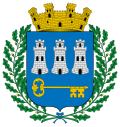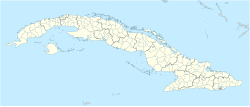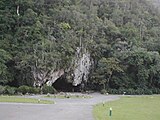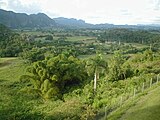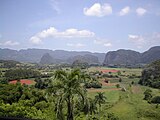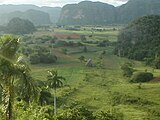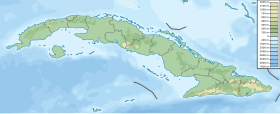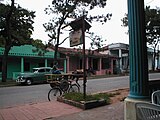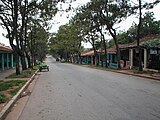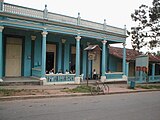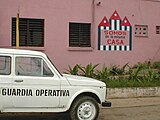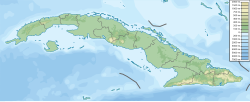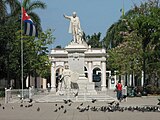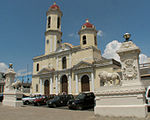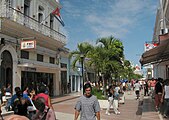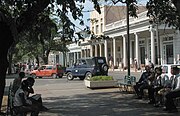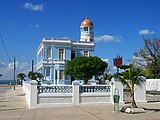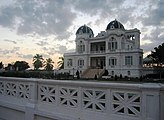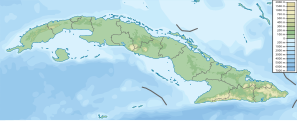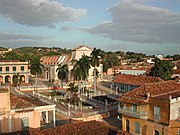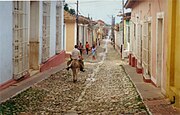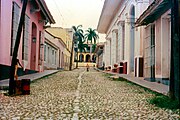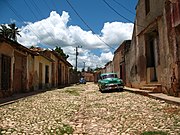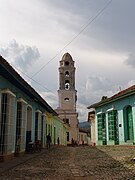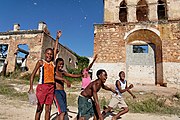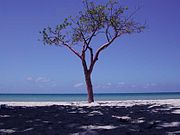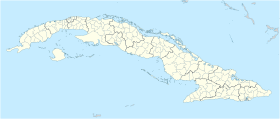User:MichielVandaele/sandbox
Cuba
[edit]Republic of Cuba República de Cuba (Spanish) | |
|---|---|
| Motto: Patria o Muerte (in Spanish) "Homeland or Death"[1] | |
| Anthem: La Bayamesa ("The Bayamo Song")[2] | |
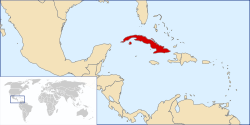 | |
| Capital and largest city | Havana 23°8′N 82°23′W / 23.133°N 82.383°W |
| Official languages | Spanish |
| Ethnic groups | 65.05% White (Spanish, others), 10.08% African, 23.84% Mulatto and Mestizo[3][failed verification] |
| Demonym(s) | Cuban |
| Government | Unitary republic, communist state[4] |
| Raúl Castro | |
• First Vice President | J. R. M. Ventura |
| Raúl Castro | |
• President of the National Assembly | Ricardo Alarcón |
| Independence from Spain/U.S. | |
• Declared | October 10, 1868 from |
• Republic declared | May 20, 1902 from the United States |
| January 1, 1959 | |
| Area | |
• Total | 109,886 km2 (42,427 sq mi) (105th) |
• Water (%) | negligible[5] |
| Population | |
• 2009 estimate | 11,239,363[5] (75th) |
• 2002 census | 11,177,743[5] |
• Density | 102/km2 (264.2/sq mi) (103rd) |
| GDP (PPP) | 2009 estimate |
• Total | $111.1 billion[6] (62nd) |
• Per capita | $9,700 (86th) |
| GDP (nominal) | 2009 estimate |
• Total | $67.26 billion[5] (62nd) |
• Per capita | $5,984 (78th) |
| HDI (2007) | 0.863[7] Error: Invalid HDI value (51st) |
| Currency | Cuban peso(CUP)Cuban convertible peso[8] (CUC) |
| Time zone | UTC-5 |
• Summer (DST) | UTC-4 ((March 11 to November 4)) |
| Drives on | right |
| Calling code | +53 |
| ISO 3166 code | CU |
| Internet TLD | .cu |
The Republic of Cuba (English pronunciation: /'kju?b?/; Spanish: República de Cuba, pronounced [re'pußlika ðe 'kußa] ) is an island nation in the Caribbean. The nation of Cuba consists of the main island of Cuba, the Isla de la Juventud, and several archipelagos. Havana is the largest city in Cuba and the country's capital. Santiago de Cuba is the second largest city.[9][10] To the north of Cuba lies the United States and the Bahamas, Mexico is to the west, the Cayman Islands and Jamaica are to the south, and Haiti and the Dominican Republic are to the southeast.
In 1492, Christopher Columbus found and claimed the island now occupied by Cuba, for the Kingdom of Spain. Cuba remained a territory of Spain until the Spanish–American War ended in 1898, and gained formal independence from the U.S. in 1902. Between 1953 and 1959 the Cuban Revolution occurred, removing the dictatorship[11] of Fulgencio Batista. A new government led by Fidel Castro was later setup. The current Cuban government is considered by the 2010 Democracy Index as "authoritarian".
Cuba is home to over 11 million people and is the most populous island nation in the Caribbean, as well as the largest by area. Its people, culture, and customs draw from diverse sources, such as the aboriginal Taíno and Ciboney peoples, the period of Spanish colonialism, the introduction of African slaves and its proximity to the United States.
Cuba has a 99.8% literacy rate,[12][13] an infant death rate lower than some developed countries,[14] and an average life expectancy of 77.64.[12] In 2006, Cuba was the only nation in the world which met the WWF's definition of sustainable development; having an ecological footprint of less than 1.8 hectares per capita and a Human Development Index of over 0.8 for 2007.[15]
Etymology
[edit]The name Cuba comes from the Taíno language. The exact meaning of the name is unclear but it may be translated either as where fertile land is abundant (cubao),[16] or great place (coabana).[17] Scholars who believe that Christopher Columbus was Portuguese state that Cuba was named by Columbus for the ancient town of Cuba in the district of Beja in Portugal.[18][19]
History
[edit]Pre-Columbian era
[edit]
Cuba was inhabited by Native American people known as the Taíno, also called Arawak by the Spanish, and Guanajatabey and Ciboney people before the arrival of the Spanish. The ancestors of these Native Americans migrated from the mainland of North, Central and South America several centuries earlier.[20] The native Tainos called the island Caobana.[21] The Taíno were farmers and the Ciboney were farmers, fishers and hunter-gatherers.
Spanish colonization
[edit]After first landing on an island then called Guanahani on October 12, 1492,[22] Christopher Columbus landed on Cuba's northeastern coast near what is now Baracoa on October 27[22] or 28.[23][24] He claimed the island for the new Kingdom of Spain[25] and named Isla Juana after Juan, Prince of Asturias.[26] In 1511, the first Spanish settlement was founded by Diego Velázquez de Cuéllar at Baracoa; other towns soon followed including the future capital of San Cristobal de la Habana which was founded in 1515. The Spanish enslaved the approximately 100,000 indigenous people who resisted conversion to Christianity,[citation needed] setting them primarily to the task of searching for gold. Within a century the indigenous people were virtually wiped out due to multiple factors, including Eurasian infectious diseases aggravated in large part by a lack of natural resistance as well as privation stemming from repressive colonial subjugation.[27] In 1529, a measles outbreak in Cuba killed two-thirds of the natives who had previously survived smallpox.[28][29]

Cuba remained a Spanish possession for almost 400 years (1511–1898), with an economy based on plantation agriculture, mining, and the export of sugar, coffee, and tobacco to Europe and later to North America. The work was done primarily by African slaves brought to the island.
The small land-owning elite of Spanish settlers held social and economic powers supported by a population of Spaniards born on the island (Criollos), other Europeans, and African-descended slaves. The population in 1817 was 630,980, of which 291,021 were white, 115,691 free black, and 224,268 black slaves.[30]
Independence wars
[edit]In the 1820s, when the rest of Spain's empire in Latin America rebelled and formed independent states, Cuba remained loyal. Although there was agitation for independence, the Spanish Crown gave Cuba the motto La Siempre Fidelísima Isla ("The Always Most Faithful Island"). This loyalty was due partly to Cuban settlers' dependence on Spain for trade, their desire for protection from pirates and against a slave rebellion, and partly because they feared the rising power of the United States more than they disliked Spanish rule.[citation needed]
Ten Years' War
[edit]
Independence from Spain was the motive for a rebellion in 1868 led by Carlos Manuel de Céspedes. De Céspedes, a sugar planter, freed his slaves to fight with him for a free Cuba. On 27 December 1868, he issued a decree condemning slavery in theory but accepting it in practice and declaring free any slaves whose masters present them for military service.[31] The 1868 rebellion resulted in a prolonged conflict known as the Ten Years' War. The United States declined to recognize the new Cuban government, although many European and Latin American nations did so.[32] In 1878, the Pact of Zanjón ended the conflict, with Spain promising greater autonomy to Cuba. In 1879–1880, Cuban patriot Calixto García attempted to start another war known as the Little War but received little support.[33]
Period between wars
[edit]In Cuba, a sophisticated and prosperous sugar industry had employed chattel slavery until the final third of the 19th century. Cuba produced 720,250 metric tons of sugar 1n 1868, more than forty percent of cane sugar reaching the world market that year. Slavery had been maintained in Cuba, however, while abolition was underway elsewhere. Abolition in Cuba began the final third of the 19th century, and was completed in the 1880s.[34][35]
War of 1895
[edit]An exiled dissident named José Martí founded the Cuban Revolutionary Party in New York in 1892. The aim of the party was to achieve Cuban independence from Spain.[36] In January 1895 Martí traveled to Montecristi and Santo Domingo to join the efforts of Máximo Gómez.[36] Martí recorded his political views in the Manifesto of Montecristi.[37] Fighting against the Spanish army began in Cuba on 24 February 1895, but Martí was unable to reach Cuba until 11 April 1895.[36] Martí was killed in the battle of Dos Rios on 19 May 1895.[36] His death immortalized him as Cuba's national hero.[37]
Around 200,000 Spanish troops outnumbered the much smaller rebel army which relied mostly on guerrilla and sabotage tactics. The Spaniards began a campaign of suppression. General Valeriano Weyler, military governor of Cuba, herded the rural population into what he called reconcentrados, described by international observers as "fortified towns". These are often considered the prototype for 20th-century concentration camps.[38] Between 200,000 and 400,000 Cuban civilians died from starvation and disease in the camps, numbers verified by the Red Cross and United States Senator and former Secretary of War Redfield Proctor. American and European protests against Spanish conduct on the island followed.[39]
Spanish–American War
[edit]USS Maine
[edit]The U.S. battleship Maine arrived in Havana on 25 January 1898 to offer protection to the 8,000 American residents on the island, but the Spanish saw this as intimidation. On the evening of 15 February 1898, the Maine blew up in the harbor, killing 252 crew. Another eight crew members died of their wounds in hospital over the next few days.[40] A Naval Board of Inquiry headed by Captain William T. Sampson was appointed to investigate the cause of the explosion on the Maine. Having examined the wreck and taken testimony from eyewitnesses and experts, the board reported on 21 March 1898 that the Maine had been destroyed by "a double magazine set off from the exterior of the ship, which could only have been produced by a mine."[40]
The facts remain disputed today, although an investigation by Admiral Hyman G. Rickover in 1976 established that the blast was most likely a large internal explosion. Rickover believes the explosion was caused by a spontaneous combustion in inadequately ventilated bituminous coal which ignited gunpowder in an adjacent magazine.[41][42] The original 1898 board was unable to fix the responsibility for the disaster, but a furious American populace, fueled by an active press— notably the newspapers of William Randolph Hearst— concluded that the Spanish were to blame and demanded action.[40] The U.S. Congress passed a resolution calling for intervention, and President William McKinley complied.[43] Spain and the United States declared war on each other in late April.
Early 20th century
[edit]After the Spanish-American War, Spain and the United States signed the Treaty of Paris (1898), by which Spain ceded Puerto Rico, the Philippines, and Guam to the United States for the sum of $20 million.[44] Under the same treaty, Spain relinquished all claim of sovereignty over Cuba. Theodore Roosevelt, who had fought in the Spanish-American War and had some sympathies with the independence movement, succeeded McKinley as U.S. President in 1901 and abandoned the treaty. Cuba gained formal independence from the U.S. on May 20, 1902, as the Republic of Cuba. Under Cuba's new constitution, the U.S. retained the right to intervene in Cuban affairs and to supervise its finances and foreign relations. Under the Platt Amendment, the U.S. leased the Guantánamo Bay naval base from Cuba.
Following disputed elections in 1906, the first president, Tomás Estrada Palma, faced an armed revolt by independence war veterans who defeated the meager government forces.[45] The U.S. intervened by occupying Cuba and named Charles Edward Magoon as Governor for three years. Cuban historians have attributed Magoon's governorship as having introduced political and social corruption.[46] In 1908, self-government was restored when José Miguel Gómez was elected President, but the U.S. continued intervening in Cuban affairs. In 1912, the Partido Independiente de Color attempted to establish a separate black republic in Oriente Province,[47] but was suppressed by General Monteagudo with considerable bloodshed.

During World War I, Cuba exported considerable quantities of sugar to Britain. Cuba was able to avoid U-boat attacks by the subterfuge of shipping the sugar to Sweden. The Menocal government declared war on Germany very soon after the United States.
A constitutional government was maintained until 1930 when Gerardo Machado y Morales suspended the constitution. During Machado's tenure, a nationalistic economic program was pursued with several major national development projects which included the Carretera Central and El Capitolio. Machado's hold on power was weakened following a decline in demand for exported agricultural produce due to the Great Depression, attacks by independence war veterans, and attacks by covert terrorist organizations, principally the ABC.[citation needed]
During a general strike in which the Communist Party sided with Machado,[48] the senior elements of the Cuban army forced Machado into exile. The Party then installed Carlos Manuel de Céspedes y Quesada, son of Cuba's founding father (Carlos Manuel de Céspedes), as President. During 4–5 September 1933, a second coup overthrew Céspedes which led to the formation of the first Ramón Grau government. Notable events in this violent period include the separate sieges of Hotel Nacional de Cuba and Atares Castle. This government lasted 100 days but engineered radical socialist changes in Cuban society, including the abolishment of the Platt Amendment and instating of womens' suffrage in Cuba. In 1934, Grau was ousted in favor of Carlos Mendieta, the first in a series of puppet presidents subordinate to the army and its young chief of staff, Fulgencio Batista.
Fulgencio Batista was democratically elected President in the elections of 1940, so far the only non-white Cuban endorsed for the nation's highest office.[49][50][51] His government carried out major social reforms. Several members of the Communist Party held office under his administration[52] and established numerous economic regulations and pro-union policies, as well as the Cuban Constitution of 1940, which engineered radical progressive ideas.[53] Batista's administration formally took Cuba to the Allies of World War II camp in World War II. Cuba declared war on Japan on December 9, 1941, then on Germany and Italy on December 11, 1941. Cuban armed forces were not greatly involved in combat during World War II, although president Batista suggested a joint U.S.-Latin American assault on Francoist Spain in order to overthrow its authoritarian regime.[54]

Ramón Grau, who lost in 1940 to Batista, finally returned in the 1944 elections by defeating Batista's preferred successor, Carlos Saladrigas Zayas. In 1948, his Revolutionary Authentic Party won again when Carlos Prío Socarrás won, the last person elected to the presidency by free and fair elections. The two terms of the Authenic Party saw an influx of investment fueled a boom which raised living standards for all segments of society and created a prosperous middle class in most urban areas. The gap between rich and poor became wider and more obvious.[55]
The 1952 election was a three-way race. Roberto Agramonte of the Ortodoxos party led in all the polls, followed by Dr. Aurelio Hevia of the Auténtico party, and Fulgencio Batista, seeking a return to office, as a distant third. Both Agramonte and Hevia had decided to name Col. Ramón Barquín to head the Cuban armed forces after the elections. Barquín, then a diplomat in Washington, DC, was a top officer. He was respected by the professional army and had promised to eliminate corruption in the ranks. Batista feared that Barquín would oust him and his followers. When it became apparent that Batista had little chance of winning, he staged a coup on 10 March 1952. Batista held on to power with the backing of a nationalist section of the army as a "provisional president" for the next two years.
In March 1952 Justo Carrillo informed Barquín in Washington that the inner circles knew that Batista had plotted the coup. They immediately began to conspire to oust Batista and restore democracy and civilian government in what was later dubbed La Conspiracion de los Puros de 1956 (Agrupacion Montecristi). In 1954, Batista agreed to elections. The Partido Auténtico put forward ex-President Grau as their candidate, but he withdrew amid allegations that Batista was rigging the elections in advance.
| “ | At the beginning of 1959 United States companies owned about 40 percent of the Cuban sugar lands – almost all the cattle ranches – 90 percent of the mines and mineral concessions – 80 percent of the utilities – practically all the oil industry – and supplied two-thirds of Cuba's imports. | ” |
| — U.S. President John F. Kennedy, 1960 [56] | ||
In April 1956 Batista ordered Barquín to become General and chief of the army, but Barquín decided to move forward with his coup to secure total power. On 4 April 1956, a coup by hundreds of career officers led by Barquín was frustrated by Rios Morejon. The coup broke the back of the Cuban armed forces. The officers were sentenced to the maximum terms allowed by Cuban Martial Law. Barquín was sentenced to solitary confinement for eight years. La Conspiración de los Puros resulted in the imprisonment of the commanders of the armed forces and the closing of the military academies.
Cuba had Latin America's highest per capita consumption rates of meat, vegetables, cereals, automobiles, telephones and radios, though this consumption was largely by the small elite class and foreigners.[57] In 1958, Cuba was a relatively well-advanced country by Latin American standards, and in some cases by world standards.[58] Cuba attracted more immigrants, primarily from Europe, as a percentage of population than the U.S. The United Nations noted Cuba for its large middle class.[citation needed] On the other hand, Cuba was affected by perhaps the largest labor union privileges in Latin America, including bans on dismissals and mechanization. They were obtained in large measure "at the cost of the unemployed and the peasants", leading to disparities.[59]
Between 1933 and 1958, Cuba extended economic regulations enormously, causing economic problems.[51][60] Unemployment became a problem as graduates entering the workforce could not find jobs.[51] The middle class, which was comparable to the United States, became increasingly dissatisfied with the unemployment. The labor unions supported Batista until the very end.[49][51]
Revolution
[edit]On 2 December 1956 a party of 82 people on the yacht Granma landed in Cuba. The party, led by Fidel Castro, had the intention of establishing an armed resistance movement in the Sierra Maestra. While facing armed resistance from Castro's rebel fighters in the mountains, Fulgencio Batista's regime was weakened and crippled by a United States arms embargo imposed on 14 March 1958. By late 1958, the rebels broke out of the Sierra Maestra and launched a general popular insurrection. After the fighters captured Santa Clara, Batista fled from Havana on 1 January 1959 to exile in Portugal. Barquín negotiated the symbolic change of command between Camilo Cienfuegos, Che Guevara, Raúl Castro, and his brother Fidel Castro after the Supreme Court decided that the Revolution was the source of law and its representatives should assume command.
Fidel Castro's forces entered the capital on 8 January 1959. Shortly afterward, a liberal lawyer, Dr Manuel Urrutia Lleó became president. He was backed by Castro's 26th of July Movement because they believed his appointment would be welcomed by the United States.[citation needed] Disagreements within the government culminated in Urrutia's resignation in July 1959. He was replaced by Osvaldo Dorticós Torrado, who served as president until 1976. Castro became prime minister in February 1959, succeeding José Miró in that post.

In its first year, the new revolutionary government expropriated private property with little or no compensation, nationalized public utilities, tightened controls on the private sector, and closed down the mafia-controlled gambling industry. The CIA conspired with the Chicago mafia in 1960 and 1961 to assassinate Fidel Castro, according to documents declassified in 2007.[61][62]
Some of these measures were undertaken by Fidel Castro's government in the name of the program outlined in the Manifesto of the Sierra Maestra.[63] The government nationalized private property totaling about USD $25 billion,[64] of which American property made up around USD $1 billion.[64][65]
By the end of 1960, the coletilla made its appearance, and most newspapers in Cuba had been expropriated, taken over by the unions, or had been abandoned.[57][66] All radio and television stations were in state control.[57] Moderate teachers and professors were purged.[57] In any year, about 20,000 dissenters were imprisoned.[57] Some homosexuals, religious practitioners, and others were sent to labor camps where they were subject to political "re-education".[67] One estimate is that 15,000 to 17,000 people were executed.[68]
The Communist Party strengthened its one-party rule, with Castro as ultimate leader.[57] Fidel's brother, Raúl Castro, became the army chief.[57] Loyalty to Castro became the primary criterion for all appointments.[69] In September 1960, the revolutionary government created a system known as Committees for the Defense of the Revolution (CDR), which provided neighborhood spying.[57]
In the 1961 New Year's Day parade, the administration exhibited Soviet tanks and other weapons.[69] Eventually, Cuba built up the second largest armed forces in Latin America, second only to Brazil.[70] Cuba became a privileged client-state of the Soviet Union.[71]
By 1961, hundreds of thousands of Cubans had left for the United States.[72] The 1961 Bay of Pigs Invasion (La Batalla de Girón) was an unsuccessful attempt to overthrow the Cuban government by a U.S.-trained force of Cuban exiles with U.S. military support. The plan was launched in April 1961, less than three months after John F. Kennedy became the U.S. President. The Cuban armed forces, trained and equipped by Eastern Bloc nations, defeated the exiles in three days. Cuban-American relations were exacerbated the following year by the Cuban Missile Crisis, when the Kennedy administration demanded the immediate withdrawal of Soviet missiles placed in Cuba placed in response to U.S. nuclear missiles in Turkey and the Middle East. The Soviets and Americans soon came to an agreement. The Soviets would remove Soviet missiles from Cuba and the Americans would remove missiles from Turkey and the Middle East. Kennedy also agreed not to invade Cuba in the future. Cuban exiles captured during the Bay of Pigs Invasion were exchanged for a shipment of supplies from America.[49]
By 1963, Cuba was moving towards a full-fledged Communist system modeled on the USSR.[73] The U.S. imposed a complete diplomatic and commercial embargo on Cuba and began Operation Mongoose, a program of covert CIA operations.
In 1965, Castro merged his revolutionary organizations with the Communist Party, of which he became First Secretary; Blas Roca was named Second Secretary. Roca was succeeded by Raúl Castro, who, as Defense Minister and Fidel's closest confidant, became and remained the second most powerful figure in Cuba until his brother's retirement. Raúl's position was strengthened by the departure of Che Guevara to launch unsuccessful insurrections in the Democratic Republic of Congo, and then Bolivia, where he was killed in 1967.
During the 1970s, Fidel Castro dispatched tens of thousands troops in support of Soviet-supported wars in Africa, particularly the MPLA in Angola and Mengistu Haile Mariam in Ethiopia.[74]
The standard of living in 1970s was "extremely spartan" and discontent was rife.[75] Fidel Castro admitted the failures of economic policies in a 1970 speech.[75] By the mid-1970s, Castro started economic reforms.
Cuba was suspended from the Organization of American States (OAS) in 1962 in support of the U.S. embargo, but in 1975 the OAS lifted all sanctions against Cuba, with approval of 16 countries, including the U.S.[76]
On 3 June 2009[dubious – discuss], the OAS adopted a resolution to end the 47-year exclusion of Cuba. The meetings were contentious, with the U.S. Secretary of State Hillary Rodham Clinton walking out at one point. However, in the end, the U.S. delegation agreed with the other members and approved the resolution. Cuban leaders have repeatedly announced they are not interested in rejoining the OAS.[77]
Recent affairs
[edit]As of 2002, some 1.2 million persons of Cuban background (about 10% of the current population of Cuba) reside in the U.S.[78][79] Many of them left the island for the United States, often by sea in small boats and fragile rafts. On 6 April 1980, 10,000 Cubans stormed the Peruvian embassy in Havana seeking political asylum. The following day, the Cuban government granted permission for the emigration of Cubans seeking refuge in the Peruvian embassy.[citation needed] On 16 April, 500 Cubans left the Peruvian Embassy for Costa Rica. On 21 April, many of those Cubans started arriving in Miami via private boats and were halted by[clarification needed] the U.S. State Department, but the emigration continued, because Castro allowed anyone who desired to leave the country to do so through the port of Mariel. Over 125,000 Cubans emigrated to the U.S. before the flow of vessels ended on 15 June.[citation needed]

Castro's rule was severely tested in the aftermath of the Soviet collapse (known in Cuba as the Special Period), with effects such as food shortages.[80][81] The government did not accept American donations of food, medicines, and cash until 1993.[80] On 5 August 1994, state security dispersed protesters in a spontaneous protest in Havana.[82]
Cuba has found a new source of aid and support in the People's Republic of China, and new allies in Hugo Chávez, President of Venezuela and Evo Morales, President of Bolivia, both major oil and gas exporters. In 2003, the government arrested and imprisoned a large number of civil activists, a period known as the "Black Spring".[83][84]
On July 31, 2006, Fidel Castro temporarily delegated his major duties to his brother, First Vice President, Raúl Castro, while Fidel recovered from surgery for an "acute intestinal crisis with sustained bleeding".[citation needed] On 2 December 2006, Fidel was too ill to attend the 50th anniversary commemoration of the Granma boat landing, fuelling speculation that he had stomach cancer,[85] although there was evidence his illness was a digestive problem and not terminal.[86]
In January 2007, footage was released of Fidel Castro meeting Venezuelan president Hugo Chávez, in which Castro "appeared frail but stronger than three months ago".[87] In February 2008, Fidel Castro announced his resignation as President of Cuba,[88] and on 24 February Raúl was elected as the new President.[89] In his acceptance speech, Raúl promised that some of the restrictions that limit Cubans' daily lives would be removed.[90] In March 2009, Raúl Castro removed some of Fidel Castro's officials.[91]
Human rights
[edit]
The Cuban government has been accused of numerous human rights abuses including torture, arbitrary imprisonment, unfair trials, and extrajudicial executions (also known as "El Paredón").[92][93] The Human Rights Watch alleges that the government "represses nearly all forms of political dissent" and that "Cubans are systematically denied basic rights to free expression, association, assembly, privacy, movement, and due process of law".[94]
Cuba had the second-highest number of imprisoned journalists of any nation in 2008 (the People's Republic of China had the highest) according to various sources, including the Committee to Protect Journalists (CPJ), an international NGO, and Human Rights Watch.[95][96] As a result of ownership restrictions, computer ownership rates are among the world's lowest.[97] The right to use the Internet is granted only to selected locations and they may be monitored.[97][98] Connecting to the Internet illegally can lead to a five-year prison sentence.[citation needed]
Cuban dissidents who commit crimes face arrest and imprisonment. In the 1990s, Human Rights Watch reported that Cuba's extensive prison system, one of the largest in Latin America, consists of some 40 maximum-security prisons, 30 minimum-security prisons, and over 200 work camps.[99] According to Human Rights Watch, political prisoners, along with the rest of Cuba's prison population, are confined to jails with substandard and unhealthy conditions.[99]
Citizens cannot leave or return to Cuba without first obtaining official permission in addition to their passport and the visa requirements of their destination.[94]
Economy
[edit]
The Cuban state adheres to socialist principles in organizing its largely state-controlled planned economy. Most of the means of production are owned and run by the government and most of the labor force is employed by the state. Recent years have seen a trend towards more private sector employment. By 2006, public sector employment was 78% and private sector 22%, compared to 91.8% to 8.2% in 1981.[100] Capital investment is restricted and requires approval by the government. The Cuban government sets most prices and rations goods. Any firm wishing to hire a Cuban must pay the Cuban government, which in turn will pay the employee in Cuban pesos.[101] Cubans can not change jobs without government permission.[51] The average wage at the end of 2005 was 334 regular pesos per month ($16.70 per month) and the average pension was $9 per month.[102]
Cuba relied heavily on trade with the Soviet Union. From the late 1980s, Soviet subsidies for Cuban goods started to dry up. Before the collapse of the Soviet Union, Cuba depended on Moscow for substantial aid and sheltered markets for its exports. The removal of these subsidies sent the Cuban economy into a rapid depression known in Cuba as the Special Period. In 1992 the United States tightened the trade embargo, hoping to see democratisation of the sort that took place in Eastern Europe.
Like some other Communist and post-Communist states following the collapse of the Soviet Union, Cuba took limited free market-oriented measures to alleviate severe shortages of food, consumer goods, and services. These steps included allowing some self-employment in certain retail and light manufacturing sectors, the legalization of the use of the US dollar in business, and the encouragement of tourism. Cuba has developed a unique urban farm system (the organopónicos) to compensate for the end of food imports from the Soviet Union. In recent years, Cuba has rolled back some of the market oriented measures undertaken in the 1990s. In 2004 Cuban officials publicly backed the Euro as a "global counter-balance to the US dollar", and eliminated U.S. currency from circulation in its stores and businesses.[citation needed]
Tourism was initially restricted to enclave resorts where tourists would be segregated from Cuban society, referred to as "enclave tourism" and "tourism apartheid".[103] Contacts between foreign visitors and ordinary Cubans were de facto illegal until 1997.[104] In 1996 tourism surpassed the sugar industry as the largest source of hard currency for Cuba. Cuba has tripled its market share of Caribbean tourism in the last decade; as a result of significant investment in tourism infrastructure, this growth rate is predicted to continue.[105] 1.9 million tourists visited Cuba in 2003, predominantly from Canada and the European Union, generating revenue of $2.1 billion.[106] The rapid growth of tourism during the Special Period had widespread social and economic repercussions in Cuba, and led to speculation about the emergence of a two-tier economy.[107] The Medical tourism sector caters to thousands of European, Latin American, Canadian, and American consumers every year.
The communist agricultural production system was ridiculed by Raúl Castro in 2008.[108] Cuba now imports up to 80% of food used for rations.[108] Before 1959, Cuba boasted as many cattle as people.
For some time, Cuba has been experiencing a housing shortage because of the state's failure to keep pace with increasing demand.[109] The government instituted food rationing policies in 1962, which were exacerbated following the collapse of the Soviet Union and the tightening of the U.S. embargo. Studies have shown that, as late as 2001, the average Cuban's standard of living was lower than before the downturn of the post-Soviet period. Paramount issues have been state salaries failing to meet personal needs under the state rationing system, chronically plagued with shortages. The variety and quantity of available rationed goods declined.
Under Venezuela's Mission Barrio Adentro, Hugo Chávez has supplied Cuba with up to 80,000 barrels (13,000 m3) of oil per day in exchange for 30,000 doctors and teachers.
In 2005 Cuba had exports of $2.4 billion, ranking 114 of 226 world countries, and imports of $6.9 billion, ranking 87 of 226 countries.[110] Its major export partners are China 27.5%, Canada 26.9%, Netherlands 11.1%, Spain 4.7% (2007).[6] Cuba's major exports are sugar, nickel, tobacco, fish, medical products, citrus, and coffee;[6] imports include food, fuel, clothing, and machinery. Cuba presently holds debt in an amount estimated to be $13 billion,[111] approximately 38% of GDP.[112] According to the Heritage Foundation, Cuba is dependent on credit accounts that rotate from country to country.[113] Cuba's prior 35% supply of the world's export market for sugar has declined to 10% due to a variety of factors, including a global sugar commodity price drop that made Cuba less competitive on world markets.[114] At one time, Cuba was the world's most important sugar producer and exporter. As a result of diversification, underinvestment, and natural disasters, Cuba's sugar production has seen a drastic decline. In 2002 more than half of Cuba's sugar mills were shut down. Cuba holds 6.4% of the global market for nickel,[115] which constitutes about 25% of total Cuban exports.[116] A 2005 US Geological Survey report estimates that the North Cuba Basin could contain 4.6 billion barrels of oil and 9.8 trillion cubic feet of natural gas.[117]
In 2010[update], Cubans were allowed to build their own houses. According to Raul Castro, they will be able to improve their houses with this new permission, but the government will not endorse these new houses or improvements.[118]
On August 2, 2011, The New York Times reported Cuba as reaffirming their intent to legalize "buying and selling" of private property before the year ends. According to experts, the private sale of property could "transform Cuba more than any of the economic reforms announced by President Raúl Castro’s government".[119] It will cut more than one million state jobs including party bureaucrats which resist the changes.[120]
Government and politics
[edit]
The Constitution of 1976, which defined Cuba as a socialist republic, was replaced by the Constitution of 1992, which is guided by the ideas of José Martí, Marx, Engels and Lenin.[122] The constitution describes the Communist Party of Cuba as the "leading force of society and of the state".[122] The first secretary of the Communist Party is concurrently President of the Council of State (President of Cuba) and President of the Council of Ministers (sometimes referred to as Prime Minister of Cuba).[123] Members of both councils are elected by the National Assembly of People's Power.[122] The President of Cuba, who is also elected by the Assembly, serves for five years and there is no limit to the number of terms of office.[122]
The Supreme Court of Cuba serves as the nation's highest judicial branch of government. It is also the court of last resort for all appeals against the decisions of provincial courts.
Cuba's national legislature, the National Assembly of People's Power (Asamblea Nacional de Poder Popular), is the supreme organ of power; 609 members serve five-year terms.[122] The assembly meets twice a year; between sessions legislative power is held by the 31 member Council of Ministers. Candidates for the Assembly are approved by public referendum. All Cuban citizens over 16 who have not been convicted of a criminal offense can vote. Article 131 of the Constitution states that voting shall be "through free, equal and secret vote".[122] Article 136 states: "In order for deputies or delegates to be considered elected they must get more than half the number of valid votes cast in the electoral districts".[122] Votes are cast by secret ballot and counted in public view. Nominees are chosen at local gatherings from multiple candidates before gaining approval from election committees. In the subsequent election, there is only one candidate for each seat, who must gain a majority to be elected.
No political party is permitted to nominate candidates or campaign on the island, though the Communist Party of Cuba has held five party congress meetings since 1975. In 1997 the party claimed 780,000 members, and representatives generally constitute at least half of the Councils of state and the National Assembly. The remaining positions are filled by candidates nominally without party affiliation. Other political parties campaign and raise finances internationally, while activity within Cuba by opposition groups is minimal and illegal.
The country is subdivided into 15 provinces and one special municipality (Isla de la Juventud). These were formerly part of six larger historical provinces: Pinar del Río, Habana, Matanzas, Las Villas, Camagüey and Oriente. The present subdivisions closely resemble those of the Spanish military provinces during the Cuban Wars of Independence, when the most troublesome areas were subdivided. The provinces are divided into municipalities.

|
Military
[edit]Cuba devoted 9–13% of its GDP to military expenditures.[124] Castro built up the second largest armed forces in Latin America; only Brazil's were larger.[70] From 1975 until the late 1980s, Soviet military assistance enabled Cuba to upgrade its military capabilities. Since the loss of Soviet subsidies Cuba has scaled down the numbers of military personnel, from 235,000 in 1994 to about 60,000 in 2003.[125] Cuba is secretive about its military spending.[124]
Foreign relations
[edit]From its inception, the Cuban Revolution defined itself as internationalist, joining Comecon in 1972. Cuba was a major contributor to Soviet-supported wars in Africa, Central America and Asia. In Africa, the largest war was in Angola, where Cuba sent tens of thousands of troops. Cuba was a friend of the Ethiopian leader Mengistu Haile Mariam.[126] In Africa, Cuba supported 17 leftist governments. In some countries it suffered setbacks, such as in eastern Zaire, but in others Cuba had significant success. Major engagements took place in Algeria, Zaire, Yemen,[127] Ethiopia, Guinea-Bissau and Mozambique.
The Cuban government's military involvement in Latin America—mostly with the aim of overthrowing U.S. backed right wing regimes, many of them dictatorial—has been extensive. One of the earliest interventions was the Marxist militia led by Che Guevara in Bolivia in 1967, though a modicum of funds and troops were sent. Lesser known actions include the 1959 missions to the Dominican Republic[128] and Panama.[citation needed] In the former, the Cuban government provided military assistance to a group of Dominican exiles with the intention of overthrowing the tyrannical dictator Rafael Trujillo. Although the expedition failed and most of its members were murdered by the government, today they are recognized as heroes and a prominent monument was erected in their memory in Santo Domingo by the Dominican government. The Museo Memorial de la Resistencia Dominicana ("Memorial Museum of the Dominican Resistance,") where the heroes of 1959 feature prominently, is being built by the Dominican Government.[129] The socialist government in Nicaragua was openly supported by Cuba and can be considered its greatest success in Latin America.[citation needed] Cuba is a founding member of the Bolivarian Alliance for the Americas. More than 30,000 Cuban doctors currently work abroad, in countries such as Venezuela and Zimbabwe.[130] The membership of Cuba in the United Nations Human Rights Council has received criticism.[131]
The European Union in 2003 accused the Cuban government of "continuing flagrant violation of human rights and fundamental freedoms".[132] In 2008, the EU and Cuba agreed to resume full relations and cooperation activities.[133] The United States continues an embargo against Cuba "so long as it continues to refuse to move toward democratization and greater respect for human rights".[134] United States President Barack Obama stated on April 17, 2009, in Trinidad and Tobago that "the United States seeks a new beginning with Cuba",[135] and reversed the Bush Administration's prohibition on travel and remittances by Cuban-Americans from the United States to Cuba.[136]
Geography
[edit]
Cuba is an archipelago of islands located in the northern Caribbean Sea at the confluence with the Gulf of Mexico and the Atlantic Ocean. It lies between latitudes 19° and 24°N, and longitudes 74° and 85°W. The United States lies to the north-west, the Bahamas to the north, Haiti to the east, Jamaica and the Cayman Islands to the south, and Mexico to the west. Cuba is the principal island, surrounded by four smaller groups of islands: the Colorados Archipelago on the northwestern coast, the Sabana-Camagüey Archipelago on the north-central Atlantic coast, the Jardines de la Reina on the south-central coast and the Canarreos Archipelago on the southwestern coast.
The main island is 1,199 km (745 mi) long, constituting most of the nation's land area (105,006 km2 (40,543 sq mi)) and is the largest island in the Caribbean and 16th-largest island in the world by land area. The main island consists mostly of flat to rolling plains apart from the Sierra Maestra mountains in the southeast, whose highest point is Pico Turquino (1,975 m (6,480 ft)). The second-largest island is Isla de la Juventud (Isle of Youth) in the Canarreos archipelago, with an area of 3,056 km2 (1,180 sq mi). Cuba has a total land area of 110,860 km2 (42,803 sq mi).
Climate
[edit]
The local climate is tropical, moderated by northeasterly trade winds that blow year-round. In general (with local variations), there is a drier season from November to April, and a rainier season from May to October. The average temperature is 21 °C (69.8 °F) in January and 27 °C (80.6 °F) in July. The warm temperatures of the Caribbean Sea and the fact that Cuba sits across the entrance to the Gulf of Mexico combine to make the country prone to frequent hurricanes. These are most common in September and October.
Resources
[edit]The most important mineral resource is nickel, of which Cuba has the world's second largest reserves (after Russia).[137] Sherritt International of Canada operates a large nickel mining facility in Moa. Cuba is the world's fifth-largest producer of refined cobalt, a byproduct of nickel mining operations.[137] Recent oil exploration has revealed that the North Cuba Basin could produce approximately 4.6 billion barrels (730,000,000 m3) to 9.3 billion barrels (1.48×109 m3) of oil. In 2006, Cuba started to test-drill these locations for possible exploitation.[138]
Demographics
[edit]| Official 1899–2002 Cuba Census[3][139][140] | ||||||||
|---|---|---|---|---|---|---|---|---|
| Race % | 1899 | 1907 | 1919 | 1931 | 1943 | 1953 | 1981 | 2002 |
| White | 66.9 | 69.7 | 72.2 | 72.1 | 74.3 | 72.8 | 66.0 | 65.05 |
| Black | 14.9 | 13.4 | 11.2 | 11.0 | 9.7 | 12.4 | 12.0 | 10.08 |
| Mulatto | 17.2 | 16.3 | 16.0 | 16.2 | 15.6 | 14.5 | 21.9 | 24.86 |
| Asian | 1.0 | 0.6 | 0.6 | 0.7 | 0.4 | 0.3 | 0.1 | ? |
Immigration to Cuba
[edit]Between 1882 and 1898, a total of 508,455 people left Spain, and more than 750,000 Spanish immigrants left for Cuba between 1899 and 1923, with many returning to Spain.[141]
Current demographics
[edit]According to the census of 2002, the population was 11,177,743,[3] including 5,597,233 men and 5,580,510 women. The racial make-up was 7,271,926 whites, 1,126,894 blacks and 2,778,923 mulattoes (or mestizos).[142] The population of Cuba has very complex origins and intermarriage between diverse groups is general. There is disagreement about racial statistics. The Institute for Cuban and Cuban-American Studies at the University of Miami says that 62% is black,[143] whereas statistics from the Cuban census state that 65.05% of the population was white in 2002. The Minority Rights Group International says that "An objective assessment of the situation of Afro-Cubans remains problematic due to scant records and a paucity of systematic studies both pre- and post-revolution. Estimates of the percentage of people of African descent in the Cuban population vary enormously, ranging from 33.9 per cent to 62 per cent".[144]

Immigration and emigration have played a prominent part in the demographic profile of Cuba during the 20th century. During the 18th, 19th, and the early part of the 20th century large waves of Canarian, Catalan, Andalusian, Galician, and other Spanish people immigrated to Cuba. Between 1900 and 1930 close to a million Spaniards arrived from Spain. Other foreign immigrants include: French,[145] Portuguese, Italian, Russian, Dutch, Greek, British, Irish, and other ethnic groups, including a small number of descendants of U.S. citizens who arrived in Cuba in the late 19th and early 20th centuries.
Cuba has a sizable number of Asian people who comprise 1% of the population. They are primarily of Chinese descent (see Chinese Cubans), followed by Filipino, Koreans and Vietnamese people. They are descendants of farm laborers brought to the island by Spanish and American contractors during the 19th and early 20th century.[citation needed] Afro-Cubans are descended primarily from the Kongo people.[citation needed], as well as several thousand North African refugees, most notably the Sahrawi Arabs of Western Sahara under Moroccan occupation since 1976.[146]
Cuba's birth rate (9.88 births per thousand population in 2006)[147] is one of the lowest in the Western Hemisphere. Its overall population increased continuously from around 7 million in 1961 to over 11 million now, but the increase has stopped in the last few decades, and a decrease began in 2006, with a fertility rate of 1.43 children per woman.[148] This drop in fertility is among the largest in the Western Hemisphere.[149] Cuba has unrestricted access to legal abortion and an abortion rate of 58.6 per 1000 pregnancies in 1996, compared to an average of 35 in the Caribbean, 27 in Latin America overall, and 48 in Europe. Contraceptive use is estimated at 79% (in the upper third of countries in the Western Hemisphere).[150]
Cuba is officially a secular state. After having long maintained that churches were fronts for subversive political activity, the government reversed course in 1992, amending the constitution to characterize the state as secular instead of atheist.[citation needed] It has many faiths representing the widely varying culture. Roman Catholicism was the largest religion; it was brought to the island by the Spanish and remains the dominant faith,[113] with 11 dioceses, 56 orders of nuns, and 24 orders of priests. In January 1998, Pope John Paul II paid a historic visit to the island, invited by the Cuban government and Catholic Church. The religious landscape of Cuba is also strongly marked by syncretisms of various kinds. Catholicism is often practiced in tandem with Santería, a mixture of Catholicism and other, mainly African, faiths that include a number of cults. La Virgen de la Caridad del Cobre (the Virgin of Cobre) is the Catholic patroness of Cuba, and a symbol of Cuban culture. In Santería, she has been syncretized with the goddess Oshun.
| Official Cuban migration to the U.S.[139][140] | |||||
|---|---|---|---|---|---|
| Year of Immigration |
White | Black | Other | Asian | Number |
| 1959–64 | 93.3 | 1.2 | 5.3 | 0.2 | 144,732 |
| 1965–74 | 87.7 | 2.0 | 9.1 | 0.2 | 247,726 |
| 1975–79 | 82.6 | 4.0 | 13.3 | 0.1 | 29,508 |
| 1980 | 80.9 | 5.3 | 13.7 | 0.1 | 94,095 |
| 1981–89 | 85.7 | 3.1 | 10.9 | 0.3 | 77,835 |
| 1990–93 | 84.7 | 3.2 | 11.9 | 0.2 | 60,244 |
| 1994–2000 | 85.8 | 3.7 | 10.4 | 0.7 | 174,437 |
| Total | 87.2 | 2.9 | 10.7 | 0.2 | 828,577 |
Three hundred thousand Cubans belong to the island's 54 Protestant denominations. Pentecostalism has grown rapidly in recent years, and the Assemblies of God alone claims a membership of over 100,000 people. Cuba has small communities of Jews, Muslims and members of the Bahá'í Faith.[151] Most Jewish Cubans are descendants of Polish and Russian Ashkenazi Jews who fled pogroms at the beginning of the 20th century. There is a sizeable number of Sephardic Jews in Cuba who trace their origin to Turkey. Most of these Sephardic Jews live in the provinces, although they maintain a synagogue in Havana.
Cuban migration
[edit]In the last half-century, several hundred thousand Cubans of all social classes have emigrated to the United States,[152] Spain, the United Kingdom, Canada, Mexico, and other countries. On 9 September 1994, the U.S. and Cuban governments agreed that the U.S. would grant at least 20,000 visas annually in exchange for Cuba's pledge to prevent further unlawful departures on boats.[153]
Languages
[edit]The official language of Cuba is Spanish and the vast majority of Cubans speak it. Spanish as spoken in Cuba is known as Cuban Spanish and is a form of Caribbean Spanish. Lucumi, a dialect of the West African language Yoruba, is also used as a liturgical language by practitioners of Santería,[154] and so only as a second language.[155] Haitian Creole is the second largest language in Cuba, and is spoken by Haitian immigrants and their descendants.[156] Other languages spoken by immigrants include Catalan and Corsican.[157]
Education
[edit]
The University of Havana was founded in 1728 and there are a number of other well-established colleges and universities. In 1957, just before Castro came to power, the literacy rate was fourth in the region at almost 80% according to the United Nations, higher than in Spain.[58][158] Castro created an entirely state-operated system and banned private institutions. School attendance is compulsory from ages six to the end of basic secondary education (normally at age 15), and all students, regardless of age or gender, wear school uniforms with the color denoting grade level. Primary education lasts for six years, secondary education is divided into basic and pre-university education.[159]
Higher education is provided by universities, higher institutes, higher pedagogical institutes, and higher polytechnic institutes. The Cuban Ministry of Higher Education operates a scheme of distance education which provides regular afternoon and evening courses in rural areas for agricultural workers. Education has a strong political and ideological emphasis, and students progressing to higher education are expected to have a commitment to the goals of Cuba.[159] Cuba has provided state subsidized education to a limited number of foreign nationals at the Latin American School of Medicine.[160][161] Internet access is limited.[162] The sale of computer equipment is strictly regulated. Internet access is controlled, and e-mail is closely monitored.[97]
Health
[edit]Historically, Cuba has ranked high in numbers of medical personnel and has made significant contributions to world health since the 19th century.[58] Today, Cuba has universal health care and although shortages of medical supplies persist, there is no shortage of medical personnel.[163] Primary care is available throughout the island and infant and maternal mortality rates compare favorably with those in developed nations.[163]
Post-Revolution Cuba initially experienced an overall worsening in terms of disease and infant mortality rates in the 1960s when half its 6,000 doctors left the country.[164] Recovery occurred by the 1980s.[49] The Communist government asserted that universal health care was to become a priority of state planning and progress was made in rural areas.[165] Like the rest of the Cuban economy, Cuban medical care suffered from severe material shortages following the end of Soviet subsidies in 1991, followed by a tightening of the U.S. embargo in 1992.[166]
Challenges include low pay of doctors (only $15 a month[167]), poor facilities, poor provision of equipment, and frequent absence of essential drugs.[168] Cuba has the highest doctor-to-population ratio in the world and has sent thousands of doctors to more than 40 countries around the world.[169]
According to the UN, the life expectancy in Cuba is 78.3 years (76.2 for males and 80.4 for females). This ranks Cuba 37th in the world and 3rd in the Americas, behind only Canada and Chile, and just ahead of the United States. Infant mortality in Cuba declined from 32 infant deaths per 1,000 live births in 1957, to 10 in 1990–95.[170] Infant mortality in 2000–2005 was 6.1 per 1,000 live births (compared to 6.8 in the United States).
The quality of public healthcare offered to citizens is regarded as the "greatest triumph" of Cuba's socialist system.[171]
Culture
[edit]Cuban culture is influenced by its melting pot of cultures, primarily those of Spain and Africa. Sport is Cuba's national passion. Due to historical associations with the United States, many Cubans participate in sports which are popular in North America, rather than sports traditionally promoted in other Spanish-speaking nations. Baseball is by far the most popular; other sports and pastimes include basketball, volleyball, cricket, and athletics. Cuba is a dominant force in amateur boxing, consistently achieving high medal tallies in major international competitions.
Music
[edit]
Cuban music is very rich and is the most commonly known expression of culture. The central form of this music is Son, which has been the basis of many other musical styles like salsa, rumba and mambo and an upbeat derivation of the rumba, the cha-cha-cha. Rumba music originated in early Afro-Cuban culture. The Tres was also invented in Cuba, but other traditional Cuban instruments are of African origin, Taíno origin, or both, such as the maracas, güiro, marimba and various wooden drums including the mayohuacan. Popular Cuban music of all styles has been enjoyed and praised widely across the world. Cuban classical music, which includes music with strong African and European influences, and features symphonic works as well as music for soloists, has received international acclaim thanks to composers like Ernesto Lecuona. Havana was the heart of the rap scene in Cuba when it began in the 1990s. During that time, reggaetón was growing in popularity. Dance in Cuba has taken a major boost over the 1990s.
Cuisine
[edit]
Cuban cuisine is a fusion of Spanish and Caribbean cuisines. Cuban recipes share spices and techniques with Spanish cooking, with some Caribbean influence in spice and flavor. Food rationing, which has been the norm in Cuba for the last four decades, restricts the common availability of these dishes.[172] The traditional Cuban meal is not served in courses; all food items are served at the same time. The typical meal could consist of plantains, black beans and rice, ropa vieja (shredded beef), Cuban bread, pork with onions, and tropical fruits. Black beans and rice, referred to as Platillo Moros y Cristianos (or moros for short), and plantains are staples of the Cuban diet. Many of the meat dishes are cooked slowly with light sauces. Garlic, cumin, oregano, and bay leaves are the dominant spices.
Literature
[edit]Cuban literature began to find its voice in the early 19th century. Dominant themes of independence and freedom were exemplified by José Martí, who led the Modernist movement in Cuban literature. Writers such as Nicolás Guillén and Jose Z. Tallet focused on literature as social protest. The poetry and novels of Dulce María Loynaz and José Lezama Lima have been influential. Romanticist Miguel Barnet, who wrote Everyone Dreamed of Cuba, reflects a more melancholy Cuba.[173] Writers such as Reinaldo Arenas, Guillermo Cabrera Infante, and more recently Daína Chaviano, Pedro Juan Gutiérrez, Zoé Valdés, Guillermo Rosales and Leonardo Padura have earned international recognition in the post-revolutionary era, though many of these writers have felt compelled to continue their work in exile due to ideological control of media by the Cuban authorities.
Havana
[edit]Havana | |
|---|---|
| La Habana | |
| Nickname: City of Columns | |
| Coordinates: 23°08′N 082°23′W / 23.133°N 82.383°W | |
| Country | Cuba |
| Province | La Habana |
| Founded | 1515(a) |
| City status | 1592 |
| Founded by | Diego Velázquez de Cuéllar |
| Municipalities | 15 |
| Government | |
| • Type | Mayor-council |
| • Mayor | Marta Hernandez Romero (PCC) |
| Area | |
• Total | 728.26 km2 (281.18 sq mi) |
| Elevation | 59 m (194 ft) |
| Population (2010)Official census[174] | |
• Total | 2,135,498 |
| • Density | 2,932.3/km2 (7,595/sq mi) |
| Demonym(s) | habanero (m), habanera (f) |
| Time zone | UTC-5 (EST) |
| • Summer (DST) | UTC-4 (EDT) |
| Postal code | 10xxx–19xxx |
| Area code | (+53) 7 |
| (a) Founded on the present site was founded in 1519. | |
Havana (Spanish: , Spanish pronunciation: [la a'ßana]), is the capital city, major port, and leading commercial centre of Cuba. The city is one of the 15 Cuban provinces. The city/province has 2.1 million inhabitants,[174] the largest city in Cuba and (city proper population) in the Caribbean region.[175] The city extends mostly westward and southward from the bay, which is entered through a narrow inlet and which divides into three main harbours: Marimelena, Guanabacoa, and Atarés. The sluggish Almendares River traverses the city from south to north, entering the Straits of Florida a few miles west of the bay.
Havana was founded by the Spanish in the 16th century and due to its strategic location it served as a springboard for the Spanish conquest of the continent becoming a stopping point for the treasure laden Spanish Galleons on the crossing between the New World and the Old World. King Philip II of Spain granted Havana the title of City in 1592.[176] The Spaniards began building fortifications, and in 1553 they transferred the governor's residence to Havana from Santiago de Cuba on the eastern end of the island, thus making Havana the de facto capital. The importance of harbour fortifications was early recognized as English, French, and Dutch sea marauders attacked the city in the 16th century.[177] The sinking of the U.S. battleship Maine in Havana's harbor in 1898 was the immediate cause of the Spanish-American War.[178]
Contemporary Havana can essentially be described as three cities in one: Old Havana, Vedado, and the newer suburban districts. Present day, the city is the center of the Cuban government, and various ministries and headquarters of businesses are based there.
History
[edit]Conquistador Diego Velázquez de Cuéllar founded Havana on August 25, 1515 or 1514, on the southern coast of the island, near the present town of Surgidero de Batabanó, or more likely on the banks of the Mayabeque River close to Playa Mayabeque. All attempts to found a city on Cuba's south coast failed, however an early map of Cuba drawn in 1514 places the town at the mouth of this river.[179][180](in Spanish). Between 1514 and 1519, the city had at least two different establishments on the north coast, one of them in La Chorrera, today in the neighborhood of Puentes Grandes, next to the Almendares River. The final city's location was adjacent to what was then called Puerto de Carenas (literally, "Careening Bay"), in 1519. The quality of this natural bay, which now hosts Havana's harbor, warranted this change of location.
Havana was the sixth town founded by the Spanish on the island, called San Cristóbal de la Habana by Pánfilo de Narváez: the name combines San Cristóbal, patron saint of Havana, and Habana, of obscure origin, possibly derived from Habaguanex, a native American chief who controlled that area, as mentioned by Diego Velasquez in his report to the king of Spain. Shortly after the founding of Cuba's first cities, the island served as little more than a base for the Conquista of other lands. Hernán Cortés organized his expedition to Mexico from the island.
Havana was originally a trading port, and suffered regular attacks by buccaneers, pirates, and French corsairs. The first attack and resultant burning of the city was by the French corsair Jacques de Sores in 1555. Such attacks convinced the Spanish Crown to fund the construction of the first fortresses in the main cities — not only to counteract the pirates and corsairs, but also to exert more control over commerce with the West Indies, and to limit the extensive contrabando (black market) that had arisen due to the trade restrictions imposed by the Casa de Contratación of Seville (the crown-controlled trading house that held a monopoly on New World trade).
Ships from all over the New World carried products first to Havana, in order to be taken by the fleet to Spain. The thousands of ships gathered in the city's bay also fueled Havana's agriculture and manufacture, since they had to be supplied with food, water, and other products needed to traverse the ocean.
On December 20, 1592, King Philip II of Spain granted Havana the title of City. Later on, the city would be officially designated as "Key to the New World and Rampart of the West Indies" by the Spanish crown. In the meantime, efforts to build or improve the defensive infrastructures of the city continued.
Havana expanded greatly in the 17th century. New buildings were constructed from the most abundant materials of the island, mainly wood, combining various Iberian architectural styles, as well as borrowing profusely from Canarian characteristics.
In 1649 a fatal epidemic brought from Cartagena in Colombia, affected a third of the population of Havana. By the middle of the 18th century Havana had more than seventy thousand inhabitants, and was the third-largest city in the Americas, ranking behind Lima and Mexico City but ahead of Boston and New York.[181]
The city was captured by the British during the Seven Years' War. The episode began on June 6, 1762, when at dawn, a British fleet, comprising more than 50 ships and a combined force of over 11,000 men of the Royal Navy and Army, sailed into Cuban waters and made an amphibious landing east of Havana.[182] The British immediately opened up trade with their North American and Caribbean colonies, causing a rapid transformation of Cuban society. Less than a year after Havana was seized, the Peace of Paris was signed by the three warring powers thus ending the Seven Years' War. The treaty gave Britain Florida in exchange for the city of Havana on the recommendation of the French, who advised that declining the offer could result in Spain losing Mexico and much of the South American mainland to the British.[183]
After regaining the city, the Spanish transformed Havana into the most heavily fortified city in the Americas. Construction began on what was to become the Fortress of San Carlos de la Cabaña, the biggest Spanish fortification in the New World. On January 15, 1796, the remains of Christopher Columbus were transported to the island from Santo Domingo. They rested here until 1898, when they were transferred to Seville's Cathedral, after Spain's loss of Cuba.
As trade between Caribbean and North American states increased in the early 19th century, Havana became a flourishing and fashionable city. Havana's theaters featured the most distinguished actors of the age, and prosperity amongst the burgeoning middle-class led to expensive new classical mansions being erected. During this period Havana became known as the Paris of the Antilles.
In 1837, the first railroad was constructed, a 51 km stretch between Havana and Bejucal, which was used for transporting sugar from the valley of Guinness to the harbor. With this, Cuba became the fifth country in the world to have a railroad, and the first Spanish-speaking country. Throughout the century, Havana was enriched by the construction of additional cultural facilities, such as the Tacon Teatre, one of the most luxurious in the world. The fact that slavery was legal in Cuba until 1886 led to Southern American interest, including a plan by the Knights of the Golden Circle to create a 'Golden Circle' with a 1200 mile-radius centered on Havana. After the Confederate States of America were defeated in the American Civil War in 1865, many former slaveholders continued to run plantations by moving to Havana.
In 1863, the city walls were knocked down so that the metropolis could be enlarged. At the end of the 19th century, Havana witnessed the final moments of Spanish colonialism in the Americas.
Republican period and Post-revolution
[edit]The 20th century began with Havana, and therefore Cuba, under occupation by the United States.
During the Republican Period, from 1902 to 1959, the city saw a new era of development. Cuba recovered from the devastation of war to become a well-off country, with the third largest middle class in the hemisphere, and Havana, the Capital of the country, became known as the "Paris of the Caribbean". Apartment buildings to accommodate the new middle class, as well as mansions for the Cuban tycoons, were built at a fast pace. Numerous luxury hotels, casinos and nightclubs were constructed during the 1930s to serve Havana's burgeoning tourist industry. In the thirties, organized crime characters were not unaware of Havana's nightclub and casino life, and they made their inroads in the city. Santo Trafficante, Jr. took the roulette wheel at the Sans Souci Casino, Meyer Lansky directed the Hotel Habana Riviera, with Lucky Luciano at the Hotel Nacional Casino. At the time, Havana became an exotic capital of appeal and numerous activities ranging from marinas, grand prix car racing, musical shows and parks.
Havana achieved the title of being the Latin American city with the biggest middle class population per-capita, simultaneously accompanied by gambling and corruption where gangsters and stars were known to mix socially. During this era, Havana was generally producing more revenue than Las Vegas, Nevada. In 1958, about 300,000 American tourists visited the city.
After the revolution of 1959, the new regime promised to improve social services, public housing, and official buildings; nevertheless, shortages that affected Cuba after Castro's abrupt expropriation of all private property and industry under a strong communist model backed by the Soviet Union followed by the U.S. embargo, hit Havana especially hard. By 1966-68, the Cuban government had nationalized all privately owned business entities in Cuba, down to "certain kinds of small retail forms of commerce" (law No. 1076[184]).
There was a severe economic downturn after the collapse of the Soviet Union in 1991. With it, subsidies ended, losing billions of dollars which the Soviet Union gave the Cuban government, with many believing Havana's soviet-backed regime would soon vanish, as happened to the Soviet satellite states of Eastern Europe. However, contrary to the soviet satellite states of Eastern Europe, Havana's communist regime prevailed during the 1990s.
After many years of prohibition, the communist government increasingly turned to tourism for new financial revenue, and has allowed foreign investors to build new hotels and develop hospitality industry. In Old Havana, effort has also gone into rebuilding for tourist purposes, and a number of streets and squares have been rehabilitated.[185] But Old Havana is a large city, and the restoration efforts concentrate in all but less than 10% of its area.
Geography
[edit]
Havana lies on the northern coast of Cuba, south of the Florida Keys, where the Gulf of Mexico joins the Caribbean Sea (map at right). The city extends mostly westward and southward from the bay, which is entered through a narrow inlet and which divides into three main harbours: Marimelena, Guanabacoa, and Atarés. The sluggish Almendares River traverses the city from south to north, entering the Straits of Florida a few miles west of the bay.
The low hills on which the city lies rise gently from the deep blue waters of the straits. A noteworthy elevation is the 200-foot-high (60-metre) limestone ridge that slopes up from the east and culminates in the heights of La Cabaña and El Morro, the sites of colonial fortifications overlooking the eastern bay. Another notable rise is the hill to the west that is occupied by the University of Havana and the Prince's Castle. Outside the city, higher hills rise on the west and east.
Climate
[edit]Havana, like much of Cuba, enjoys a pleasant year-round tropical climate that is tempered by the island's position in the belt of the trade winds and by the warm offshore currents. Under the Köppen climate classification, Havana has a tropical savanna climate. Average temperatures range from 72 °F (22 °C) in January and February to 82 °F (28 °C) in August. The temperature seldom drops below 50 °F (10 °C). The lowest temperature was 33 °F (1 °C) in Santiago de Las Vegas, Boyeros. The lowest recorded temperature in Cuba was 32 °F (0 °C) in Bainoa, Havana province. Rainfall is heaviest in June and October and lightest from December through April, averaging 46 inches (1,200 mm) annually. Hurricanes occasionally strike the island, but they ordinarily hit the south coast, and damage in Havana has been less than elsewhere in the country.
The table below lists temperature averages throughout the year:
| Climate data for Havana | |||||||||||||
|---|---|---|---|---|---|---|---|---|---|---|---|---|---|
| Month | Jan | Feb | Mar | Apr | May | Jun | Jul | Aug | Sep | Oct | Nov | Dec | Year |
| Mean daily maximum °C (°F) | 25.8 (78.4) |
26.1 (79.0) |
27.6 (81.7) |
28.6 (83.5) |
29.8 (85.6) |
30.5 (86.9) |
31.3 (88.3) |
31.6 (88.9) |
31.0 (87.8) |
29.2 (84.6) |
27.7 (81.9) |
26.5 (79.7) |
28.8 (83.8) |
| Mean daily minimum °C (°F) | 18.6 (65.5) |
18.6 (65.5) |
19.7 (67.5) |
20.9 (69.6) |
22.4 (72.3) |
23.4 (74.1) |
23.8 (74.8) |
24.1 (75.4) |
23.8 (74.8) |
23.0 (73.4) |
21.3 (70.3) |
19.5 (67.1) |
21.6 (70.9) |
| Average rainfall mm (inches) | 64.4 (2.54) |
68.6 (2.70) |
46.2 (1.82) |
53.7 (2.11) |
98.0 (3.86) |
182.3 (7.18) |
105.6 (4.16) |
99.6 (3.92) |
144.4 (5.69) |
180.5 (7.11) |
88.3 (3.48) |
57.6 (2.27) |
1,189.2 (46.84) |
| Average rainy days (≥ 1.0 mm) | 5 | 5 | 3 | 3 | 6 | 10 | 7 | 9 | 10 | 11 | 6 | 5 | 80 |
| Average relative humidity (%) | 75 | 74 | 73 | 72 | 75 | 77 | 78 | 78 | 79 | 80 | 77 | 75 | 76 |
| Source: World Meteorological Organisation (UN),[186] Climate-Charts.com[187] | |||||||||||||
Cityscape
[edit]Contemporary Havana can essentially be described as three cities in one: Old Havana, Vedado, and the newer suburban districts. Old Havana, with its narrow streets and overhanging balconies, is the traditional centre of part of Havana's commerce, industry, and entertainment, as well as being a residential area.
To the north and west a newer section, centred on the uptown area known as Vedado, has become the rival of Old Havana for commercial activity and nightlife. Centro Habana, sometimes described as part of Vedado, is mainly a shopping district that lies between Vedado and Old Havana. The Capitolio Nacional building marks the beginning of Centro Habana, a working class neighborhood.[188] Chinatown and the Real Fabrica de Tabacos Partagás, one of Cuba's oldest cigar factories is located in the area.[189]
A third Havana is that of the more affluent residential and industrial districts that spread out mostly to the west. Among these is Marianao, one of the newer parts of the city, dating mainly from the 1920s. Some of the suburban exclusivity was lost after the revolution, many of the suburban homes having been nationalized by the Cuban government to serve as schools, hospitals, and government offices. Several private country clubs were converted to public recreational centres. Miramar, located west of Vedado along the coast, remains Havana's exclusive area; mansions, foreign embassies, diplomatic residences, upscale shops, and facilities for wealthy foreigners are common in the area.[190] The International School of Havana is located in the Miramar neighborhood.
In the 1980s many parts of Old Havana, including the Plaza de Armas, became part of a projected 35-year multimillion-dollar restoration project, for Cubans to appreciate their past and boost tourism. In the past ten years, with the assistance of foreign aid and under the support of local city historian Eusebio Leal Spengler, large parts of Habana Vieja have been renovated. The city is moving forward with their renovations, with most of the major plazas (Plaza Vieja, Plaza de la Catedral, Plaza de San Francisco and Plaza de Armas) and major tourist streets (Obispo and Mercaderes) near completion.
Architecture
[edit]Due to Havana's more than five hundred year existence, the city boasts some of the most diverse styles of architecture in the world. From castles built in the late 16th century to modernist present-day high-rises.
- Neoclassical
Neoclassism was introduced into the city in the 1840s, at the time including Gas public lighting in 1848 and the railroad in 1837. In the second half of the 18th century, sugar and coffee production increased rapidly, which became essential in the development of Havana's most prominent architectural style. Many wealthy Habaneros took their inspiration from the French; this can be seen within the interiors of upper class houses such as the Aldama Palace built in 1844. This is considered the most important neoclassical residential building in Cuba and typifies the design of many houses of this period with portales of neoclassical columns facing open spaces or courtyards.
In 1925 Jean-Claude Nicolas Forestier, the head of urban planning in Paris moved to Havana for five years to collaborate with architects and landscape designers. In the master planning of the city his aim was to create a harmonic balance between the classical built form and the tropical landscape. He embraced and connected the city's road networks while accentuating prominent landmarks. His influence has left a huge mark on Havana although many of his ideas were cut short by the great depression in 1929. During the first decades of the 20th century Havana expanded more rapidly than at any time during its history. Great wealth prompted architectural styles to be influenced from abroad. The peak of Neoclassicism came with the construction of the Vedado district (begun in 1859). This whole neighbourhood is littered with set back well-proportioned buildings.
- Colonial and Baroque
Riches were brought from the colonialists into and through Havana as it was a key transshipment point between the new world and old world. As a result Havana was the most heavily fortified city in the Americas. Most examples of early architecture can be seen in military fortifications such as La Fortaleza de San Carlos de la Cabana (1558–1577) designed by Battista Antonelli and the Castillo del Morro (1589–1630). This sits at the entrance of Havana Bay and provides an insight into the supremacy and wealth at that time.
Old Havana was also protected by a defensive wall begun in 1674 but had already overgrown its boundaries when it was completed in 1767, becoming the new neighbourhood of Centro Habana. The influence from different styles and cultures can be seen in Havana's colonial architecture, with a diverse range of Moorish architecture, Spanish, Italian, Greek and Roman. The San Carlos and San Ambrosio Seminary (18th century) is a good example of early Spanish influenced architecture. The Havana cathedral (1748–1777) dominating the Plaza de la Catedral (1749) is the best example of Cuban Baroque. Surrounding it are the former palaces of the Count de Casa-Bayona (1720–1746) Marquis de Arcos (1746) and the Marquis de Aguas Claras (1751–1775).
- Art Deco and Eclectic
The first echoes of the Art Deco movement in Havana started in 1927, in the residential area of Miramar.[191] The Edificio Bacardi (1930) is thought to be the best example of Art-deco architecture in the city and first tall Art Deco building as well,[191] followed by the Hotel Nacional de Cuba (1930) and The Lopez Serrano building built in 1932 by Ricardo Mira inspired by the Rockefeller Center in New York. The year 1928 marked the beginning of the reaction against the Spanish Renaissance style architecture, Art Deco started in the lush and wealthy suburbs of Miramar, Marianao, and Vedado.[191]
The city's eclectic architectural sights begins in Centro Habana.[192] The Central Railway Terminal (1912), and the Museum of the Revolution (1920) are example of Eclectic architecture.
 |
- Modernism
Many high-rise office buildings, and apartment complexes, along with some hotels built in the 1950s dramatically altered the skyline. Modernism, therefore, transformed much of the city and should be noted for its individual buildings of high quality rather than its larger key buildings. Examples of the latter are Habana Libre (1958), which before the revolution was the Havana Hilton Hotel and La Rampa movie theater (1955).
Famous architects such as Walter Gropius, Richard Neutra and Oscar Niemeyer all passed through the city,[193] while strong influences can be seen in Havana at this time from Le Corbusier and Ludwig Mies van der Rohe.[194] The Edificio Focsa (1956) represents Havana's economic dominance at the time. This 35-story complex was conceived and based on Corbusian ideas of a self-contained city within a city. It contained 400 apartments, garages, a school, a supermarket, and restaurant on the top floor. This was the tallest concrete structure in the world at the time (using no steel frame) and the ultimate symbol of luxury and excess. The Havana Riviera Hotel (1957) designed by Irving Feldman, a twenty-one-story edifice, when it opened, the Riviera was the largest purpose-built casino-hotel in Cuba or anywhere in the world, outside Las Vegas (the Havana Hilton (1958) surpassed its size a year later).
Landmarks
[edit]- Fortaleza San Carlos de la Cabaña, a fortress located on the east side of the Havana bay, La Cabaña is the most impressive fortress from colonial times, particularly its walls constructed at the end of the 18th century.
- El Capitolio Nacional, built in 1929 as the Senate and House of Representatives, this colossal building is recognizable by its dome which dominates the city's skyline. Inside stands the third largest indoor statue in the world, La Estatua de la República. Nowadays, the Cuban Academy of Sciences headquarters and the Museo Nacional de Historia Natural (the National Museum of Natural History) has its venue within the building and contains the largest natural history collection in the country.
- Castillo de los Tres Reyes Magos del Morro is a picturesque fortress guarding the entrance to Havana bay; Morro Castle was built because of the threat to the harbor from pirates.
- Castillo San Salvador de la Punta, a small fortress built in the 16th century, at the western entry point to the Havana harbour, it played a crucial role in the defence of Havana during the initial centuries of colonisation. It houses some twenty old guns and military antiques.
- Cristo de La Habana, Havana's 20-meter (66 ft) marble statue of Christ (1958) blesses the city from the east hillside of the bay, much like the famous Cristo Redentor in Rio de Janeiro.
- The Great Theatre of Havana, famous particularly for the acclaimed National Ballet of Cuba, it sometimes hosts performances by the National Opera. The theater is also known as concert hall, García Lorca, the biggest in Cuba.
- Hotel Nacional de Cuba, an Art Deco National Hotel.
- El Malecón Habanero, the avenue that runs beside the seawall along the north shore of Havana, from Habana Vieja to the Almendares River, it forms the northern boundary of Old Havana, Centro Habana and Vedado.
- Museo de la Revolución, located in the former Presidential Palace, with the yacht Granma on display behind the museum.
- Necrópolis Cristóbal Colón, a cemetery and open air museum,[195] it is one of the most famous cemeteries in Latin America, known for its beauty and magnificence. The cemetery was built in 1876 and has nearly one million tombs. Some gravestones are decorated with sculpture by Ramos Blancos, among others.
Coat of arms
[edit]Culture
[edit]| UNESCO World Heritage Site | |
|---|---|
| Criteria | Cultural: iv, v |
| Reference | 204 |
| Inscription | 1982 (6th Session) |
Havana, by far the leading cultural centre of the country, offers a wide variety of features that range from museums, palaces, public squares, avenues, churches, fortresses (including the largest fortified complex in the Americas dating from the 16th through 18th centuries), ballet and from art and musical festivals to exhibitions of technology. The restoration of Old Havana offered a number of new attractions, including a museum to house relics of the Cuban revolution. The government placed special emphasis on cultural activities, many of which are free or involve only a minimal charge.
Before the Communists, Havana cinema rivalled New York City and Paris. As Guillaume Carpentier put it in a Le Monde article, "With nationalisation, they closed one by one, for lack of maintenance, films or electricity... Havana, Cubans complain, is a cemetery of cinemas. It is also a cemetery of bookshops, markets, shops..."[196]
Old Havana
[edit]Old Havana, (La Habana Vieja in Spanish), contains the core of the original city of Havana, with more than 2,000 hectares it exhibits almost all the Western architectural styles seen in the New World. La Habana Vieja was founded by the Spanish in 1519 in the natural harbor of the Bay of Havana. It became a stopping point for the treasure laden Spanish Galleons on the crossing between the New World and the Old World. In the 17th century it was one of the main shipbuilding centers. The city was built in baroque and neoclassic style. Many buildings have fallen in ruin but a number are being restored. The narrow streets of old Havana contain many buildings, accounting for perhaps as many as one-third of the approximately 3,000 buildings found in Old Havana.[197]
Old Havana is the ancient city formed from the port, the official center and the Plaza de Armas. Alejo Carpentier called Old Havana the place "de las columnas" (of the columns). The Cuban government is taking many steps to preserve and to restore Old Havana, through the Office of the city historian, directed by Eusebio Leal.[198] Old Havana and its fortifications were added to the UNESCO World Heritage List in 1982.[199]
Chinatown
[edit]Havana's Chinatown (Barrio Chino), once Latin America's largest and most vibrant Chinatown[200][201][202] incorporated into the city by the early part of the 20th century when hundreds of thousands of Chinese workers were brought in by Spanish settlers from from Guangdong, Fujian, Hong Kong, and Macau via Manila, Philippines[203] starting in the mid-19th century and the following decades to replace and / or work alongside African slaves.[204] After completing 8-year contracts, many Chinese immigrants settled permanently in Havana.
The first 206 Chinese-born to arrived in Havana was on June 3, 1847.[205] The Chinatown neighborhood was booming with Chinese restaurants, laundries, banks, pharmacies, theaters and several Chinese-language newspapers, the neighborhood comprised 44 square blocks during its prime.[200][204] The heart of Havana's Chinatown is on el Cuchillo de Zanja (or The Zanja Canal). The strip is a pedestrian-only street adorned with many red lanterns, dancing red paper dragons and other Chinese cultural designs, there is a great number of restaurants that serve a full spectrum of Chinese dishes – unfortunately that 'spectrum' is said by many not to be related to real Chinese cuisine.
The Chinatown district has two paifang, a large one located on Calle Dragones, the People's Republic of China donated the materials in the late 1990s,[206] it has a well defined written welcoming sign in Chinese and Spanish. The smaller arch is located on Zanja strip. The Cuban's Chinese boom ended when Fidel Castro's 1959 revolution seized private businesses, sending tens of thousands of business-minded Chinese fleeing, mainly to the United States. Descendants are now making efforts to preserve and revive the culture.[201]
Visual arts
[edit]The National Museum of Fine Arts (Museo Nacional de Bellas Artes) is a Fine Arts museum that exhibits Cuban and International art collections. The museum houses one of the largest collections of paintings and sculpture from Latin America and is the largest in the Caribbean region.[207] Under the Cuban Ministry of Culture, it occupies two buildings in the vicinity of Havana's Paseo del Prado, these are the Palace of Fine Arts, devoted to Cuban art and the Palace of the Asturian Center, dedicated to universal art.[208] Its artistic heritage is made ??up of over 45,000 pieces.[209]
The Museum of the Revolution (Museo de la Revolución), designed in Havana by Cuban architect Carlos Maruri, and the Belgian Paul Belau, who came up with an eclectic design, harmoniously combines Spanish, French and German architectural elements. The museum was the Presidential Palace in the capital; today, its displays and documents outline Cuba's history from the beginning of the neo-colonial period.
The neo-classical mansion of the Countess of Revilla de Camargo, today it is the Museum of Decorative Arts (Museo de Artes Decorativas), known as the "small French Palace of Havana" built between 1924 and 1927, it was designed in Paris inspired in French Renaissance.[210] A lavish display of 18th and 19th century European treasures that recall a time when Havana was known as the Paris of the Antilles, and many luxury goods, including porcelain from Worcester, Meissen and Sèvres, were imported.[211] In the French room, there is a marble bust of Marie Antoinette smiling demurely. There is also another room with Chinese screens, another one featuring English furniture and landspcape painting. The museum has been exhibiting more than 33,000 works dating from the reigns of Louis XV, Louis XVI, and Napoleon III; as well as 16th to 20th century Oriental pieces, among many other treasures.[212] The Museum has ten permanent exhibit halls. Among them are prominent porcelain articles from the factories in Sèvres and Chantilly, France; Meissen, Germany; and Wedgwood, England, as well as Chinese from the Qianlong Emperor period and Japanese from the Imari. The furniture comes from Stéphane Boudin, Jean Henri Riesener and several others.
Several museums in Old Havana houses furniture, silverware, pottery, glass and other items from the colonial period. One of these is the Palace of the General Captains, where Spanish governors once lived. The Casa de Africa presents another aspect of Cuba's history, it houses a large collection of Afro-Cuban religious artifacts.
Other museums in the icty includes Casa de los Árabes (House of Arabs) and the Casa de Asia (House of Asia) with Middle and Far Eastern collections. Havana's Museo del Automobil has an impressive collection of vehicles dating back to a 1905 Cadillac. In the Automobile museum there is also the Rolls Royce which belonged to Fulgencio Batista, and the 1960 Chevrolet that Che Guevara drove.
While most museums of Havana are situated in Old Havana, few of them can also be found in Vedado. In total, Havana has around 50 museums, including the National Museum of Music; the Museum of Dance and Rum; the Cigar Museum; the Napoleonic, Colonial and Oricha Museums; the Museum of Anthropology; the Ernest Hemingway Museum; the José Martí Monument; the Aircraft Museum (Museo del Aire). There are also museums of Natural Sciences, the City, Archeology, Gold-and-Silverwork, Perfume, Pharmaceuticals, Sports, Numismatics, and Weapons.
Performing arts
[edit]Facing Havana's Central Park is the baroque Great Theatre of Havana, a prominent theatre built in 1837.[213] It is now home of the National Ballet of Cuba and the International Ballet Festival of Havana, one of the oldest in the New World. The façade of the building is adorned with a stone and marble statue. There are also sculptural pieces by Giuseppe Moretti,[214] representing allegories depicting benevolence, education, music and theatre. The principal theatre is the García Lorca Auditorium, with seats for 1,500 and balconies. Glories of its rich history; the Italian tenor Enrico Caruso sang, the Russian ballerina Anna Pavlova danced, and the French Sarah Bernhardt acted.
Other important theatres in the city includes the National Theater of Cuba, housed in a huge modern building located in Plaza de la Revolucion, decorated with works by Cuban artists. The National Theater includes two main theatre stages, the Avellaneda Auditorium and the Covarrubias Auditorium, as well as a smaller theatre workshop space on the ninth floor.
The Karl Marx Theater with its large auditorium have a seating capacity of 5,500 spectators, is generally used for concerts and other events, it is also one of the venues for the annual Havana Film Festival.
Festivals
[edit]- Havana Film Festival (The International Festival of New Latin American Cinema)
- International Ballet Festival of Havana
- Havana International Jazz Festival
Economy
[edit]Industry
[edit]Havana has a diversified economy, with traditional sectors, such as manufacturing, construction, transportation and communications, and new or revived ones such as biotechnology and tourism. Havana's economy first developed on the basis of its location, which made it one of the early great trade centres in the New World. Sugar and a flourishing slave trade first brought riches to the city, and later, after independence, it became a renowned resort. Despite efforts by Fidel Castro's government to spread Cuba's industrial activity to all parts of the island, Havana remains the centre of much of the nation's industry.
The traditional sugar industry, upon which the island's economy has been based for three centuries, is centred elsewhere on the island and controls some three-fourths of the export economy. But light manufacturing facilities, meat-packing plants, and chemical and pharmaceutical operations are concentrated in Havana. Other food-processing industries are also important, along with shipbuilding, vehicle manufacturing, production of alcoholic beverages (particularly rum), textiles, and tobacco products, particularly the world-famous Habanos cigars.[215] Although the harbours of Cienfuegos and Matanzas, in particular, have been developed under the revolutionary government, Havana remains Cuba's primary port facility; 50% of Cuban imports and exports pass through Havana. The port also supports a considerable fishing industry.
In 2000, nearly 89% of the city's officially recorded labour force worked for government-run agencies, institutions or enterprises. Havana, on average, has the country’s highest incomes and human development indicators. After the collapse of the Soviet Union, Cuba re-emphasized tourism as a major industry leading to its recovery. Tourism is now Havana and Cuba's primary economic source.[216]
Tourism
[edit]Havana has long been a popular attraction for tourists. Between 1915 and 1930, Havana hosted more tourists than any other location in the Caribbean.[217] The influx was due in large part to Cuba's proximity to the United States, where restrictive prohibition on alcohol and other pastimes stood in stark contrast to the island's traditionally relaxed attitude to leisure pursuits.
It was tourism's association to the world of gambling and prostitution during the Republic Period which made the revolutionary government established in 1959 approach the entire sector as a social evil to be eradicated. Many bars and gambling venues were closed down following the revolution and a government body, the National Institute of the Tourism Industry, took over many facilities (traditionally available to wealthy) to make them accessible to the general public.
With the deterioration of Cuba – United States relations and the imposition of the trade embargo on the island in 1961, tourism dropped drastically and did not return to anything close to its pre-revolution levels until 1989. The revolutionary government in general, and Fidel Castro in particular, initially opposed any considerable development of the tourism industry, linking the sphere to the debauchery and criminal activities of times past. In the late 1970s, however, Castro changed his stance and, in 1982, the Cuban government passed a foreign investment code which opened a number of sectors, tourism included, to foreign capital.
Through the creation of firms open to such foreign investment (such as Cubanacan), Cuba began to attract capital for hotel development, managing to increase the number of tourists from 130,000 (in 1980) to 326,000 (by the end of that decade).
Havana has also been a popular health tourism destination for more than 20 years. Foreign patients travel to Cuba, Havana in particular, for a wide range of treatments including eye-surgery, neurological disorders such as multiple sclerosis and Parkinsons disease, and orthopaedics. Many patients are from Latin America, although medical treatment for retinitis pigmentosa, often known as night blindness, has attracted many patients from Europe and North America.[218][219]
Commerce and finance
[edit]After the Revolution, Cuba's traditional capitalist, American dominated, free-enterprise system was replaced by a heavily socialized economic system. The majority of business in Cuba is in the hands of the state. In Havana Cuban-owned businesses and U.S.-owned businesses were nationalized and today most businesses operate solely under state control.
In Old Havana and throughout Vedado there are a several small private businesses, such as shoe-repair shops or dressmaking facilities, but their number is steadily declining. Banking as well is also under state control, and the National Bank of Cuba, headquartered in Havana, is the control center of the Cuban economy. Its branches in some cases occupy buildings that were in pre-revolutionary times the offices of Cuban or foreign banks.
In the late 1990s Vedado, located along the Caribbean waterfront, started to represent the principal commercial area. It was developed extensively between 1930 and 1960, when Havana developed as a major destination for U.S. tourists; high-rise hotels, casinos, restaurants, and upscale commercial establishments, many reflecting the art deco style.[220]
Vedado is today Havana's financial district, the main banks, airline companies offices, shops, most businesses headquarters, numerous high-rise apartments and hotels, are located in the area.[221] The University of Havana is located in Vedado.
Transportation
[edit]Transport
[edit]During the Republic Period, the city was renowned for an excellent network of public transportation by bus, trams and taxi. A subway system modeled after that of New York City was proposed in 1921.[222][223]
In the 1980s there were also plans for a Metro system in Havana similar to Moscow's, as a result of the Soviet Union influence in Cuba at the time. The studies of geology and finance made ??by Cuban and Soviet specialists were already well advanced in the 1980s.[224] The Cuban press showed the construction project, and even the course route, linking municipalities and neighborhoods in the capital.[224] In the late 1980s the project had already began, each mile of track was worth a million dollars at the time, but with the fall of the Soviet Union the project was later dropped.[224]
- Air
Havana is served by José Martí International Airport.
The Airport lies about 11 kilometres (7 mi) south of the city center, and is the main hub of Cubana de Aviación, the airport is Cuba's main international and domestic getaway, it serves several million passengers each year, 80% of Cuba's international passengers along with Varadero's Airport, it handles flights from over 20 international airlines serving more than 60 worldwide destinations, mainly in Europe, North, Central and South America and over 3 national airlines serving 16 domestic destinations. Havana is also served by Playa Baracoa Airport which is small airport to the west of city used for some domestic flights, primarily Aerogaviota. Cuban passengers are required to obtain a permit from the authorities to leave the island, known as the White Card, and those Cubans living abroad are required a visa to enter the country.
- Rail
Havana has a network of suburban, interurban and long-distance rail lines, the only one in the Caribbean region.[225] The railways are nationalised and run by the UFC (Union de Ferrocarriles de Cuba – Union for Railways of Cuba).
Rail service connects Havana from the Central Rail Station, La Coubre Rail Station and Casablanca Station to various Cuban provinces. In 2004 the annual passenger volume was some 11 million,[226] but demand is estimated at two-and-a-half to three times this value, with the busiest route being between Havana and Santiago de Cuba, some 836 kilometres (519 mi) apart by rail. In 2000 the Union de Ferrocarriles de Cuba bought French first class airconditioned coaches.
- Bus
The Havana public buses are carried out by two divisions, Omnibus Metropolitanos (OM) and Metrobus.[226]
The Metrobus serves the inner-city urban area, with a maximum distance of 20 km (12 mi).[226] Its fleet have been modernized, but formerly in 2006 were known as "camellos" (camels). The camellos operated on the busiest routes and were trailers transformed into buses known as camels, so called for their two humps. The Metrobus consists of 17 main lines, identified with the letter "P" with long-distance routes. The stops are usually 800–1,000 metres (2,600–3,300 ft), with frequent buses in peak hours, about every 10 minutes. It uses large modern articulated buses, such as the Chinese-made Yutong brand, Russian-made Liaz, or MAZ of Belarus.
The Omnibus Metropolitanos (OM), known as the Metrobus feeder line, connects the adjacent towns and cities in the metropolitan area with the city center, with a maximum distance of 40 km (25 mi).[226] This division has one of the most used and largest urban bus fleets in the country, its fleet is made up of mostly new Chinese Yutong buses,[227] but as well older Busscar buses. In 2008 the Cuban government invested millions of dollars for the acquisition of 1,500 new Yutong urban buses.
Administration
[edit]Government
[edit]Havana is administered by a city-provincial council, with a mayor as chief administrative officer. Thus, Havana functions as both a city and a province, the city has little autonomy and dependent upon the national government, particularly, for much of its budgetary and overall political direction.
The national government is headquartered in Havana and plays an extremely visible role in the city's life. Moreover, the all-embracing authority of many national institutions has led to a declining role for the city government, which, nevertheless, still provides much of the essential services and has competences in education, health care, city public transport, garbage collection, small industry, agriculture, etc.
Voters elect delegates to Municipal Assemblies in competitive elections. There is only one political party, the Communist Party, but since there must be a minimum of two candidates, members of the Communist Party often run against each other. Candidates are not required to be members of the party. They are nominated directly by citizens in open meetings within each election district. Municipal Assembly delegates in turn elect members of the Provincial Assembly, which in Havana serves roughly as the City Council; its president functions as the Mayor. There are direct elections for deputies to the National Assembly based on slates, and a portion of the candidates is nominated at the local level. The People’s Councils (Consejos Populares) consist of local municipal delegates who elect a full-time representative to preside over the body. In addition, there is participation from "mass organisations" and representatives of local government agencies, industries and services. The 105 People’s Councils in Havana cover an average of 20,000 residents.
Havana city borders are contiguous with the Mayabeque Province on the south and east and to Artemisa Province on the west, since former La Habana Province (rural) was abolished in 2010. Havana is divided into 15 constituent municipalities. Before 1963, current city territory was divided into six independent municipalities, being Havana one of them. Between 1963 and 1976, the Metropolitan Havana "Regional" was established, with six subdivisions; but in 1976 the city's borders were expanded to include the entire metropolitan area, 15 municipalities were created and the city received the province status.
The city is divided into 15 municipios – municipalities or boroughs. (Numbers refer to map).
Demographics
[edit]
By the end of 2009, 19.1% of the population of Cuba lived in Havana.[174] According to the census of 2009, the population was 2,141,993[174] (6,139 less from the previous year),[174] including 1,032,687 men and 1,109,306 women. The city has an average life expectancy of 76.81 years at birth.[174] In 2009, there were 1,924 people living with HIV/AIDS in the city, 78.9% of these are men, and 21.1% being women.[230]
According to the 1981 Havana's official race census [231] (the Cuban census and similar studies use the term "skin colour" instead of "race"),
- White: 63.4%, (many of Galician and Canarian ancestry)[232]
- Afro-Cuban: 16.4%, (whose ancestors were slaves)
- mulatto (mixed-race): 20.4%
- Asian: 0.2% (reflecting immigration from China in the late 19th and early 20th centuries)[232]
There are few mestizos contrary to many other Latin American countries, because the Native Indian population was virtually wiped out in colonial times.

The development and opportunity offered by Cuba in the 1920s-1950s, and Havana in particular, made the capital a magnet for immigration during the Republic period, mostly from various regions of Spain. Havana agglomeration grew rapidly during the first half of the XX century reaching 1 million inhabitants in the 1943 census. The con-urbanization expanded over the Havana municipality borders into neighbor municipalities of Marianao, Regla and Guanabacoa. Starting from the 80's, the city’s population is growing slowly as a result of balanced development policies, low birth rate, its relatively high rate of emigration abroad, and controlled domestic migration. Because of the city and country’s low birth rate and high life expectancy,[12][13] its age structure is similar to a developed country, with Havana having an even higher proportion of elderly than the country as a whole.[174]
The Cuban government controls the movement of people into Havana on the grounds that the Havana metropolitan area (home to nearly 20% of the country's population) is overstretched in terms of land use, water, electricity, transportation, and other elements of the urban infrastructure. There is a population of internal migrants to Havana nicknamed "palestinos" (Palestinians),[233] sometimes considered a racist term,[234] these mostly hail from the eastern region of Oriente.[235]
The city's significant minority of Chinese, mostly Cantonese ancestors, were brought in the mid-19th century by Spanish settlers via the Philippines with work contracts and after completing 8-year contracts many Chinese immigrants settled permanently in Havana.[232] Before the revolution the Chinese population counted to over 200,000,[236] today, Chinese ancestors could count up to 100,000.[237] Chinese born/ native Chinese (mostly Cantonese as well) are around 400 presently.[238] There are some 3,000 Russians living in the city, as reported by the Russian Embassy in Havana, they're mostly women that married Cubans who had gone to the Soviet Union to study.[239] Havana also shelters other non-Cuban population of an unknown size. There is a population of several thousand North African teen and pre-teen refugees.[240]
Roman Catholics form the largest religious group in Havana. The Jewish community in Havana has reduced after the Revolution from once having embraced more than 15,000 Jews,[241] many of whom had fled Nazi persecution and subsequently left Cuba to Miami or returned to Israel after Castro took to power in 1959. The city once had five synagogues, but only three remain (one Orthodox, one Conservative and one Sephardic), Beth Shalom Grand Synagogue is one of them. In February 2007 the New York Times estimated that there were about 1,500 known Jews living in Havana.[242]
Poverty and slums
[edit]| Housing Units and Population of Havana Slums[243][244] | ||||||||
|---|---|---|---|---|---|---|---|---|
| Housing type | Year | Units | Population | % of Total Pop. | ||||
| cuartería(a) | 2001 | 60,754 | 206,564 | 9.4 | ||||
| slums/ ghetto | 2001 | 21,552 | 72,986 | 3.3 | ||||
| shelters | 1997 | 2,758 | 9,178 | 0.4 | ||||
| (a)A cuartería (or ciudadela, solar) is a large inner-city old mansion or hotel or boarding house subdivided into rooms, sometimes with over 60 families.[245] | ||||||||
The national government does not have an official definition of poverty.[246] The government researchers argue that "poverty" in most commonly accepted meanings does not really exist in Cuba, but rather that there is a sector of the population that can be described as "at risk" or "vulnerable" using internationally accepted measures.[246] Indeed, it does not publicly report household income figures in the Census or in its Statistical Yearbook. Soon after the revolution the government lowered prices on goods and services; assure equal access to low-cost essential food and consumer goods through rationing; and extend the social security system to the entire population.
The generic term "slum" is seldom used in Cuba, substandard housing is described: housing type, housing conditions, building materials, and settlement type. The National Housing Institute considers units in solares (a large inner-city mansion or older hotel or boarding house subdivided into rooms, sometimes with over 60 families)[245] and shanty towns to be the "precarious housing stock" and tracks their number. Most slum units are concentrated in the inner-city municipalities of Old Havana and Centro Habana, as well as such neighbourhoods as Atarés in Regla.[244] People living in slums have access to the same education, health care, job opportunities and social security as those who live in formerly privileged neighbourhoods. Shanty towns are scattered throughout the city except for in a few central areas.[244]
Over 9% of Havana’s population live in cuartería (solares, ciudadela), 3.3% in shanty towns, and 0.3% in refugee shelters.[243][244] This does not include an estimate of the number of people living in housing in "fair" or "poor" condition because in many cases these units do not necessarily constitute slum housing but rather are basically sound dwellings needing repairs. According to Instituto Nacional de Vivienda (National Housing Institute) official figures, in 2001, 64% of Havana’s 586,768 units were considered in "good" condition, up from 50% in 1990. Some 20% were in "fair" condition and 16% in "poor" condition.[244] Partial or total building collapses are not uncommon, although the number had been cut in half by the end of the 1990s as the worst units disappeared and others were repaired. Buildings in Old Havana and Centro Habana are especially exposed to the elements: high humidity, the corrosive effects of salt spray from proximity to the coast, and occasional flooding.
Infrastructure
[edit]Education
[edit]The national government assumes all responsibility for education, and there are adequate primary, secondary, and vocational training schools throughout Havana. The Cuban National Ballet School with 4,350 students is the biggest ballet school in the world and the most prestigious ballet school in Cuba,[247] In 2002 with the expansion of the school, out of 52,000 students interested to join the school, 4,050 were selected.[248] All children receive an education. The schools are of varying quality and education is free and compulsory at all levels except higher learning, which is also free. The University of Havana, located in the Vedado section of Havana, was established in 1728 and was regarded as a leading institution of higher learning in the Western Hemisphere. Soon after the Revolution, the university, as well as all other educational institutions, were nationalized. Since then several other universities have opened, like the Polytechnic Institute "Jose Antonio Echeverria" where the vast majority of today's Cuban engineers are formed.
Health
[edit]All Havana residents have free access to health care in hospitals,[249] local polyclinics, and neighbourhood family doctors who serve on average 170 families each,[250] which is one of the highest doctor-to-patient ratio in the world.[251] However, the health system has suffered from shortages of supplies, equipment and medications caused by the US embargo and the ending of the Soviet Union subsidies in the early 1990s.[252] Nevertheless, Havana’s infant mortality rate in 2009 was 4.9 per 1,000 live births,[174] 5.12 in the country as a whole, which is lower than many developed nations,[253][254] and the lowest in the developing world.[253][254][255] Administration of the health care system for the nation is centred largely in Havana. Hospitals in Havana are run by the national government, and citizens are assigned hospitals and clinics to which they may go for attention.
Services
[edit]Utility services are under the control of several nationalized state enterprises that have developed since the Cuban revolution. Water, electricity, and sewage service are administered in this fashion. Electricity is supplied by generators that are fueled with oil. Much of the original power plant installations, which operated before the Revolutionary government assumed control, have become somewhat outdated. Electrical blackouts occurred, prompting the national government in 1986 to allocate the equivalent of $25,000,000 to modernize the electrical system.
 |
 |
Sports
[edit]Many Cubans are avid sports fans who particularly favour baseball. Havana's teams in the Cuban National Series are Industriales and Metropolitanos. The city has several large sports stadiums, the largest one is the Estadio Latinoamericano. Admission to sporting events is generally free, and impromptu games are played in neighborhoods throughout the city. Social clubs at the beaches provide facilities for water sports and include restaurants and dance halls.
- Havana was host to the 11th Pan American Games in 1991. Stadiums and facilities for this were built in the relatively unpopulated eastern suburbs.
- Havana was host to the 1992 IAAF World Cup in Athletics.
- Havana was a candidate to host the 2012 Summer Olympic Games, but was not shortlisted.
Get around
[edit]
By taxi
[edit]As a tourist, the most convenient way of getting around Havana is by taxi. Some of the taxis are old American Chevys from the 1950's, others are (somewhat) newer Russian Ladas, whilst most tourist taxis are modern Peugeots, Skodas and even Mercedes.
It is illegal for tourists to ride in anything other than the official government taxis. However, it is often easier to wave down one of the old Chevys or Ladas. When riding in an illegal taxi, negotiate the fare ahead of time. The fare in illegal taxis will be no cheaper than the official taxi fare. Around the city, taking illegal taxis should be no problem. However, taking an illegal taxi to or from the airport may attract the attention of the police.
Taxi collectivos are the old, beaten-up yank-tanks with a taxi sign on the roof or in the front window. Tourists are not supposed to take them, but you will rarely run into problems and they are a fun and cheap alternative to the state-run taxis. They have set fares and run set routes, so you may need some assistance when taking them the first few times.
Fares vary from 10 CUP for a short (5 km) run during the day to 20 CUP for a longer run or at night. The drivers are generally honest regarding the fares, but it is best not to appear oblivious by asking how much at the end of the trip. Always watch what the other passengers give: if in doubt, give only 10 CUP unless the driver asks for another 10. There can be a long wait trying to get a taxi collectivo as they are very popular with Cubans and often full, but the experience and the savings make it worthwhile.
Coco Taxis and yellow three wheel motorbikes are a cheap way of getting around central Havana.
By bus
[edit]Havana used to have a public transportation service called the El Camello, a split-level bus pulled by a semi-truck, and resembling a 2 humped camel (thus the name). Camellos finished operation in April 2008 and were replaced by modern city buses imported from China.
The cost of riding the new city bus is 1 national peso to anywhere in the city (the driver will not give you change). Expect some overcrowding, there are plenty of buses running though, so if the one you want is full simply wait for the next one. There are few clearly marked bus stops on route, but it's clear where they stop usually as you will have other waiting at the side of the road.
Other local buses can also get crowded, but in the suburbs, they are a practical means of transport for visitors.
By car
[edit]Hiring a car can be an interesting experience as the road signs are not particularly good. Some travelers suggest picking up hitchhikers and using their local expertise to get you where you want to go. There is one high way constructed by the Soviet Union on the island's northern side. It was not finished due to the fall of the Soviet Union, but is the easiest way to head east-west. Most other roads are in terrible condition. If you are leaving Havana, make sure you do it in an air conditioned jeep, as normal cars cannot be expected to cope with the terrain of the "roads".
By cycle
[edit]Cycling can be a great way to get around Cuba. There are a number of international tour companies [3] [4] that offer guided tours, the most popular is from Havana to Santiago de Cuba. If you are traveling in February and March avoid the west to east approach as the trade winds are tough to cycle against.
By foot
[edit]Walking around Havana is by far the best way to see and experience the city: get a decent map of the city and discover new sights on foot.
See
[edit]- Museum of the Revolution and the Capitol Building.
- Visit the Partagas cigar factory just behind the Capitol Building (cost 10CUC for a half hour guided tour). Please note that there is no photography allowed. It is the place where you can also be sure to get the correct cigars in the shop - more expensive than 'street offers' - but the quality of these offers is definitely questionnable.
- Plaza Vieja What is now called the Old Square was originally Plaza Nueva (New Square), built as a popular alternative to Plaza de Armas, the military and government nerve center. Later called Plaza del Mercado (Market Square) as Havana's commercial hub, Plaza Vieja was the site of executions, processions, bullfights, and fiestas -- all witnessed by Havana's wealthiest citizens, who looked on from their balconies. The original Carrara marble fountain surrounded by four dolphins was demolished in the 1930s when President Gerardo Machado (1871-1939) built an underground parking lot here. Today the square's surrounding structures vary wildly in condition, though all of them are noteworthy.
- Havana Club Rum Factory. Go on a guided tour of Havana Club, one of Cuba's most famous rums. Most of the exhibits are subtitled in English and are fairly self-explanatory.
- Walk along the Prado street in the evening. Great public space - unfortunately not illuminated at night. The Prado hums with street life, cafes and charm.
- Walk along El Malecón. A favorite stroll for tourists and locals, a walk along the Malecon runs along the main streets of Havana and provides stunning views of the Bay.
- Enjoy the glory of La Habana Vieja (The Old Town), some of it faded and crumbling - but there are many beautifully restored buildings as a result of the UNESCO World Heritage Site designation.
- Plaza de la Revolución. Huge square dominated by a statue and monument of Jose Marti and the iconic image of Che Guevara adorning the Ministry of the Interior. Arrive either early or late, as it is often swamped by tourists and gets very hot during the day.
- John Lennon Park in Vedado. Features the only statue of a western musician in Havana. Notable for the regularly stolen (and replaced) eyeglasses.
- The US Special Interests building in Vedado, just off the Malecon. In the absence of a United States embassy in Cuba, this heavily fortified and guarded building is where Cuban citizens go to apply for US Visas. It was notable for displaying news which is unfiltered and not censored by the Cuban government on electronic billboards situated behind the windows of one of the floors, but these were switched off in 2009. It is also the focus for regularly staged protests.
- Hotel Habana Libre in Vedado. The hotel housed Castro's soldiers for several days after they took Havana. It has an excellent selection of photos in the lobby along with one of the only 24 hour fast food restaurants in the city.
- Enjoy extraordinary 360-degree views of the city using the large Camara Oscura in the old town.
- The Catedral de San Cristobal in old Havana. Said to be the only example of a baroque construction that possesses asymmetrical features, one of the towers is wider than the other.
- Plaza de Armas. Spacious and elegant, the square is surrounded by baroque constructions that give it a authentic colonial milieu. It was laid out during the 1600s, replacing an old plaza which acted as the center of religious, administrative and military activity. Until the mid-18th century, it was used for military exercises and parades. After its remodeling between the years 1771-1838, it became a favored meeting spot for the city's wealthy. Today it is also known as Céspedes Park, in honor of the country´s Founding Father, whose monument stands at its center. This square is one of the most outstanding in the city, enlivened by vendors of antiques and classical books on Latin American and world literature. Attractions of remarkable historical value lay around the square such as the capok tree (Ceiba) under which the first mass for the city´s founding was officiated in 1519.
- Castillo de La Real Fuerza is the oldest bastioned fortress in the New World and has now reopened as a Cuba’s premier maritime museum. (There is also a small naval museum in Cienfuegos.)
The museum contains excellent exhibits of Cuba’s maritime past, from pre-Columbian days through to the 18th Century with the Royal Shipyard of Havana, one of the largest in the world which built nearly 200 ships for the Spanish Crown. The museum features a huge four metre model of the Santisima Trinidad, located on the main floor with a large interactive touch screen, which describes life aboard an 18th Century ship-of-the-line in Spanish, French, and English. The original ship was launched into Havana Bay on March 2, 1769 and was the largest ship in the world in the 18th Century, with 140 cannons on four gun decks. She was one of four Cuban-built ships at the Battle of Trafalgar in 1805.
Downstairs you will find ancient navigational instruments, underwater archaeological artifacts, and gold and silver from the colonial era. Also note the original weathervane, La Giraldilla, while her replica moves in the breeze on the top of the fortress tower, which commands a fantastic view of the city. The second level of the museum hosts many other historic and contemporary models of ships with links to Cuba and is also a good location for viewing the harbour and city skyline.
Do
[edit]
- Walk along the Malecón, the sea wall that runs along the Havana coastline. On weekends this is where the locals come to party, so bring a bottle and join in.
- Latin American New Cinema Festival, [5] is a popular event held every December, screening international films and drawing around 500,000 people.
- Tropicana Show — A cabaret show that costs 90CUC. It is a must see show while you are in Havana.
- Take a tour in an old car — For around 20-30CUC an hour for up to four people, be driven around Havana in style. Choose a car you like near the Hotel Inglaterra or outside the Museum of the Revolution.
- Go to the eastern beaches (Playas del Este) — There's a bus leaving from Hotel Inglaterra every 30 minutes. Price is 5 CUC for a roundtrip. The ride takes about 30 minutes.
Live Music
[edit]Nearly every restaurant and hotel in town has a decent house band playing old favorites.
- Hotel Nacional often hosts big name talent such as Omara Portuondo.
- La Zorra y el Cuervo, La Rampa, (near the Hotel Habana Libre). A tiny little club below street level, they often host funky and amazing jazz musicians. Go there for something a little different.
- La Tropical is a venue designed to hold several thousand people. It only opens for live music. Look around for signs in the streets publicising the next event.
- Casa de la Musica de Centro Habana is the place to be if you like to dance Salsa. Check the program before you buy tickets, there are different top-rated salsa bands playing every night.
- Museo del Ron offers a very nice outdoors 50's Cuban music show called Buena Vista. You can watch it with or without dinner. 50CUC with dinner.
Eat
[edit]San Cristobal Paladar
[edit]Cuisines: Cuban
Adres: San Rafael No 469, Havana, Cuba
Tel: 860-1705
Restaurant La Casa
[edit]Cuisines: Cuban, French, Italian, Tapas
30 | Calle 30 #865 e/ 26 y 41 Nuevo Vedado, Havana 10400, Cuba
537 8817000 | www.restaurantelacasacuba.com
Luca's Bar & Grill
[edit]Price range*: $4–18
Cuisines: Italian, Cuban, Mediterranean, International
Recommended For: Romance, Large groups, Doing business
Address: 15 no. 13 e/2da y 4ta | Guiteras Habana Del Este, Havana 12800, Cuba
Tel: 537-766-2579
Punto G
[edit]Price range*: $7–17
Cuisines: Café, Cuban, Spanish
Address: Calle 17#360esq G, Havana, Cuba
Tel: 005378328354
La Guarida
[edit]Cuisines: Fusion
Concordia. No. 418 | Gervasio y Escobar, Havana 10700, Cuba
+53 7 8669047 | www.laguarida.com/
Viñales
[edit]| UNESCO World Heritage Site | |
|---|---|
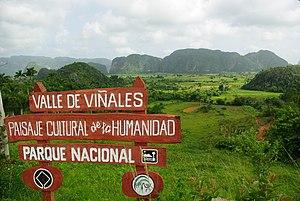 | |
| Criteria | Cultural: iv |
| Reference | 840 |
| Inscription | 1999 (23rd Session) |

Viñales Valley (Spanish: Valle de Viñales) is a karstic depression in Cuba. The valley has an area of 132 km2 (51 sq mi) and is located in the Sierra de los Organos, just north of Viñales in the Pinar del Río Province.
Tobacco and other crops are cultivated on the bottom of the valley, mostly by traditional agriculture techniques. Many caves dot the surrounding hillfaces (Cueva del Indio, Cueva de José Miguel).
The conspicuous cliffs rising like islands from the bottom of the valley are called mogotes.
Viñales is a major tourist destination offering mainly hiking and rock climbing. The local climbing scene has started to take off in the last few years with many new routes being discovered resulting in an increase in local tourism.[256]
Conservation
[edit]Many endemic plants and animals are specific to this valley. Flora found in the region include Bombax emarginatum, Mountain Palm (Gaussia princeps), Ekmanianthe actinophilla, and Microcycas calocoma. Fauna includes Bee Hummingbird (Mellisuga helenae, zunzún), Cuban Trogon (Priotelus temnurus), Cuban Tody (Todus multicolor), Cuban Solitaire (Myadestes elisabeth) and Cuban Grassquit (Tiaris canorus).[257]
UNESCO Heritage site
[edit]In 1999, the Viñales Valley was designated a UNESCO World Heritage Site as a cultural landscape, both for its natural beauty and for the vernacular architecture and traditions.
Photo gallery
[edit]-
Palenque de los Cimarrones
-
Viñales Valley
-
Fog over Viñales Valley
-
Viñales Valley
-
Viñales Valley
-
Viñales Valley
Viñales | |
|---|---|
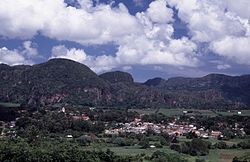 Overview of Viñales | |
Location of Viñales in Cuba | |
| Coordinates: 22°36′55″N 83°42′57″W / 22.61528°N 83.71583°W | |
| Country | |
| Province | Pinar del Río |
| Settled | 1871 |
| Established | 1878 |
| Area | |
• Total | 704 km2 (272 sq mi) |
| Elevation | 135 m (443 ft) |
| Population (2004)[258] | |
• Total | 27,129 |
| • Density | 38.5/km2 (100/sq mi) |
| Time zone | UTC-5 (EST) |
| Area code | +53-82 |
Viñales is a small town and municipality in the north-central Pinar del Rio Province of Cuba.
The town consists mostly of one-story wooden houses with porches.
The municipality is dominated by low mountain ranges of the Cordillera de Guaniguanico such as Sierra de los Órganos. Typical outcrops known as mogotes complete the karstic character of the landscape.[259]
History
[edit]
Before European settlement, the area was the home of a remnant Taíno population swelled with runaway slaves.[260]
The area was colonised at the beginning of the 1800s by tobacco growers from the Canary Islands, who settled in the Vuelta Abajo region.
The first settlement in Viñales is documented in 1871, in the form of a ranch belonging to Don Andrés Hernández Ramos.
The town was established in 1878 as a typical community, with church, school, hospital and recreation park.[261]
Economy
[edit]

Viñales is an agricultural area, where crops of fruit, vegetables, coffee and especially tobacco are grown by traditional methods. Fishing is also an important part of the area's economy.
Tourism
[edit]
Tourism centered on the Viñales Valley is developing, the area being protected by constitution since February 1976, and declared a national monument in October 1978. The Viñales Valley has been listed as a UNESCO World Heritage Site since November 1999,[262] for the outstanding karst landscape and traditional agriculture as well as vernacular architecture, crafts and music.
Attractions in Viñales include the Museo Municipal, Casa de Caridad Botanical Gardens, Museo Paleontológico, Palenque (a Maroon village)[260] and the nearby caves (Cueva del Indio, Cueva de José Miguel, Cueva de Santo Tomás) in Valle de Viñales National Park,[263] which were refuges for runaway slaves.[260] There is also a cave that doubles as a nightclub.
Casas particulares (private residences that have been tailored and licensed to operate as bed and breakfasts) offer accommodations to visitors year-round. There are also three hotels located a few kilometers outside of town, rated three stars: La Ermita, Los Jazmines, and Rancho Horizontes San Vicente. The campismo Dos Hermanas comprises 54 cabins (available to tourists), a swimming pool and restaurante..
Demographics
[edit]In 2004, the municipality of Viñales had a population of 27,129 with a 0.69%/year increase.[258] With a total area of 704 km2 (272 sq mi),[229] it has a population density of 38.5/km2 (100/sq mi).
See also
[edit]-
A man rides down the main street in Viñales
-
Downtown Viñales
-
A Viñales cafe
-
Local government graffiti: We are from the same house
Pinar del Río
[edit]Pinar del Río | |
|---|---|
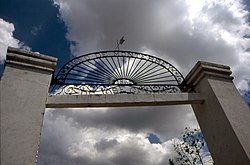 Cigar factory in Pinar del Río | |
Location of Pinar de Río in Cuba | |
| Coordinates: 22°24′44″N 83°40′19″W / 22.41222°N 83.67194°W | |
| Country | |
| Province | Pinar del Río |
| Founded | 1774 |
| Area | |
| 708 km2 (273 sq mi) | |
| • Urban | 70.7 km2 (27.3 sq mi) |
| Elevation | 60 m (200 ft) |
| Population (2004)[258] | |
| 190,532 | |
| • Density | 269.1/km2 (697/sq mi) |
| • Urban | 152,200 |
| • Urban density | 2,152.8/km2 (5,576/sq mi) |
| Time zone | UTC-5 (EST) |
| • Summer (DST) | UTC-4 (EDT) |
| Area code | +53-48 |
| Highways | Carretera Central |
| Website | Pinar del Río webpage |

Pinar del Río is a city in Cuba. It is the capital of Pinar del Río Province.
Inhabitants of the area are called Pinareños.
Neighborhoods in the city include La Conchita, La Coloma, Briones Montoto and Las Ovas.
History
[edit]Pinar del Río was one of the last major cities in Cuba founded by the Spanish. The city and province was originally founded as Nueva Filipinas (New Philippines) due to the large influx of Filipinos who had arrived by traveling on the Manila Galleons. They brought with them tamarind (also known as sampaloc), camisa de chinos, and arroz caldo (also known as arroz caldoso)
Known as Chinos Manila among the local population, the Filipinos worked the huge tobacco plantations much as they did in the present provinces of Ilocos Sur, Tarlac, Ilocos Norte, Cagayan and Isabela in their home country. During that time, the Spanish colonizers had a virtual monopoly of the tobacco trade through their company, the Tabacalera.
The world renowned La Flor de Isabela cigars (named after her Royal Majesty Queen Isabella II) were first cultivated in the Philippines in the Hacienda San Fernando, Hacienda Isabel, Hacienda Antonio and the Hacienda Luisita (all of these haciendas were later purchased by the Tabacalera or the Compañía General de Tabacos de Filipinas sociedad anonima). After Mexico declared independence (1815), the trade of the Manila Galleons was broken. The Tabacalera shifted the cultivation of these cigars to Cuba since the Philippines was too far to govern without Mexico in between. The Isabela cigars achieved much fame due in part because of the American's appetite for cigars when Havana was a Las Vegas-style playground before the tenure of President Fidel Castro.
Nueva Filipinas was renamed Pinar del Río in 1774 at the same time that the old colonial capital of Guane lost its superiority.
(Previously, the old capital of Guane was named after the Gaane district in the Maluku Islands. During the Spanish times, the area was referred to as Las Islas Moluccas. Gaane in Indonesia is still located in the southern tip of Halmahera island. To this day, the Moluccas island group is the only area in predominantly Muslim Indonesia that has a Christian majority. The Moluccas or Spice Islands is also the scene of ongoing violent communal fighting between Christians and Muslim Jihad groups. During the 16th and 17th centuries, Ternate island was the most important of the Moluccas islands in Indonesia. Ternate island is right off the coast of nearby Halmahera island where the town of Gaane is also located. At that time, Spain, Portugal, England and the Netherlands quarreled over their claim to get hold of the monopoly of the spice trade of the world. In fact, Isabella I of Castile (for whom the city of Isabela, Basilan and Isabela (province), Philippiines was named) and her husband Ferdinand II of Aragon coveted the islands so much they sent Christopher Columbus and many conquistadores to find it. In 1655, however, the Spaniards had to withdraw from the Moluccas in order to concentrate their forces in Manila. This was to fortify themselves against the threatened attack of a Chinese warlord, Koxinga. In moving out of the Moluccas, the Spanish missionary who went with the troops took along with him some 200 Moluccas Christians, better known as Márdikas. To this band of 200 Moluccas Indonesian immigrants can be traced the origin of Chabacano or Creole Spanish in the Philippines).
Afterwards, some Filipinos moved to Havana's big Barrio Chino or Chinatown. Others jumped ship to Louisiana. Others sailed back to Sinaloa and Jalisco in Mexico. Those with money went to Spain or back to Manila (and brought with them Escabeche a la Cubana which is a favorite dish to all Filipinos which they almost always serve using fish). The rest intermarried with the Cuban population.
Those who stayed quickly lost their Filipino ties since many among the Filipinos were like the local Cubans. They can speak Spanish, they were Catholic, they have to pay taxes or tributos, and they were treated like slaves by their Spanish masters. (Back in the Philippines, entire provinces were assigned to grow tobacco and nothing more. Those caught stealing a single leaf of tobacco or caught growing the food staple, rice, were hit with sugarcane or sentenced to death by garrote). Nonetheless, their children survive to this day. That is why there are Filipino or Chinese-Filipino sounding surnames in Cuba, such as Tampico, Magalan (from Magalang or to show respect), Batunbacal (from Batungbakal), Maquilin, Sumayao (to dance), Parian, Mabolo, Pilapil, Alimoron (from Alimurung), Nacpil, Gotiaco, Piat, Singson or Singzon, Tuason or Tuazon, Hizon or Hison, Dizon or Dison, Hinojosa or Hinohosa, Gandionco, Quiambao, Salambao, Puyat, Edralin, et al.
Important Cuban-Filipinos include the Azcarraga Fessner family, whose patriarch was Marcelo de Azcarraga y Palmero, the first Prime Minister of Spain with Indian blood, whose mother was a Filipina from the Lizarrabal and Palmero families. [264]
During a 1970s state visit to Cuba, Philippine First Lady Imelda Marcos remarked on the similarities of Cuba to the Philippines, including coconuts, tobacco leaves, mountains, carabaos, and food. Both peoples enjoyed cockfighting, playing mah jong, dama and cara y cruz, and eating lechon. Many older Filipinos and Cubans have a sense of bilateral cultural affinity that eclipses that with geographically adjacent nations.
Economy
[edit]The city is located in a major tobacco-growing area and is a centre of the cigar industry. The main farming tool in this province is the Carabao which is similar to the Carabaos in the Philippines.
Cayo Conuco
[edit]Cayo Conuco is a municipality in Pinar del Río. The closest airport is LCL - La Coloma, located 20.0 km south of Cayo Conuco.[265]
Education
[edit]The main secondary education institution is the University of Pinar del Río.
Demographics
[edit]In the 2002 national census, the following statistics were recorded:
- Area: 70.7 km² (city); 708 km² (municipality)
- Population: 189,221 (total); 152,200 (city); 30,417 (surrounding rural area)
- Density: 270,4 /km²
In 2004, the municipality of Pinar del Río had a population of 190,532.[258] With a total area of 708 km2 (273 sq mi),[229] it has a population density of 269.1/km2 (697/sq mi).
Notable people
[edit]- Danys Báez, currently plays for the Philadelphia Phillies
- Mario Bencomo, an internationally exhibited painter
- René Capo, moved to the United States at an early age, becoming an Olympic Judoka.
- Willy Chirino, Cuban Singer-Song Writer
- Yunesky Maya, pitcher for the Washington Nationals
- Rudy Pérez, composer and producer
- Alexei Ramírez, currently plays for the Chicago White Sox
Cienfuegos
[edit]Cienfuegos | |
|---|---|
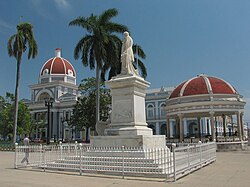 Marti Park and City Hall | |
| Nickname: La Perla del Sur (Pearl of the South) | |
Location of Cienfuegos in Cuba | |
| Coordinates: 22°08′44″N 80°26′11″W / 22.14556°N 80.43639°W | |
| Country | |
| Province | Cienfuegos |
| Founded | 1819[266] |
| Area | |
• Total | 333 km2 (129 sq mi) |
| Elevation | 25 m (82 ft) |
| Population (2004)[258] | |
• Total | 163,824 |
| • Density | 492.0/km2 (1,274/sq mi) |
| Time zone | UTC-5 (EST) |
| Area code | +53-43 |
Cienfuegos is a city on the southern coast of Cuba, capital of the province of Cienfuegos. It is located about 250 km (155 miles) from Havana, and has a population of 150,000. The city is dubbed "La Perla del Sur" (Pearl of the South). Cienfuegos literally translates to "Hundred fires".
Geography
[edit]Near the entrance to Bahia de Cienfuegos (bahia meaning "bay") is Castillo de Jagua (full name Castillo de Nuestra Señora de los Angeles de Jagua), a fortress erected in 1745 for protection against Caribbean pirates.
Cienfuegos, one of the chief seaports of Cuba, is a center of the sugar trade, as well as coffee and tobacco. While sugarcane is the chief crop, local farmers grow coffee.
The downtown contains 6 buildings from 1819–50, 327 buildings from 1851–1900, and 1188 buildings from the 20th century. There is no other place in the Caribbean which contains such a remarkable cluster of Neoclassical structures.
Demographics
[edit]In 2004, the municipality of Cienfuegos had a population of 163,824.[258] With a total area of 333 km2 (129 sq mi),[229] it has a population density of 492.0/km2 (1,274/sq mi).
History
[edit]The area was called the Cacicazgo de Jagua by the early Spaniards, and was settled by indigenous people.
The city was settled by French immigrants from Bordeaux and Louisiana, led by Don Louis D'Clouet, on April 22, 1819.[266] Its original name was Fernardina de Jagua, in honor of Ferdinand VII of Spain[citation needed]. The settlement became a town (Spanish: Villa) in 1829, and a city in 1880. The city was subsequently named Cienfuegos, sharing the name with Cienfuegos, a Captain General in this time, in the island.
Near Cienfuegos was the scene of a battle on May 11, 1898, between American marines who attempted to sever underwater Spanish communication lines and the Spanish defenders.
During the Cuban Revolution the city saw an uprising against Fulgencio Batista and was bombed, on September 5, 1957.[267]
World Heritage Site
[edit]| UNESCO World Heritage Site | |
|---|---|
 | |
| Criteria | Cultural: ii, v |
| Reference | 1202 |
| Inscription | 2005 (29th Session) |
In 2005, UNESCO inscribed the Urban Historic Centre of Cienfuegos on the World Heritage List, citing Cienfuegos as the best extant example of the 19th-century early Spanish Enlightenment implementation in urban planning.[268]
Hurricane Dennis 2005
[edit]In 2005, Hurricane Dennis made its second landfall near Cienfuegos at about 1:00PM AST (17:00 UTC) with winds of 232 km/h (144 MPH), and gusts reaching 285 km/h (177 MPH).
Attractions
[edit]
- Castillo de Nuestra Señora de los Ángeles de Jagua - fortress
- Arco de Triunfo - the only Arco de Triunfo in Cuba
- Cathedral de la Purisma Concepcion - cathedral with stained glass work, built 1833-1869.
- Delfinario - dolphins and sea lions in a saltwater lagoon
- Jardín Botánico de Cienfuegos - 97 hectares of botanic garden
- Museo Provincial - furniture and porcelain museum
- Palacio de Valle - built 1913-1917 in neo-gothic style
- Palmira Yorubá Pantheon - museum of religious afro-catholic syncretism
- Parque José Martí - park in Plaza de Armas
- University of Cienfuegos "Carlos Rafael Rodríguez" (UCF) - the province's secondary education institution.
- El Nicho Waterfalls
Famous residents
[edit]- Benny Moré, Cuban singer.
- Cristóbal Torriente, Cuban-born Hall of fame Baseball player.
- Gina Pellón, Cuban painter, lives in exile in Paris.
- Maria Conchita Alonso, Cuban-Venezuelan-American singer was born here.
- Luis Posada Carriles, Cuban anti-Castro terrorist allegedly responsible for the Cubana Flight 455 bombing, among other terrorist attacks, was born here.
- Joe Azcue, MLB player for the Cincinnati Reds, Kansas City Athletics, Cleveland Indians, Boston Red Sox, California Angels, and the Milwaukee Brewers.
Gallery
[edit]-
Statue of José Martí
-
Cathedral of Cienfuegos
-
Pedestrian Boulevard
-
Prado
-
Palacio de Valle (Valle's Palace) in Punta Gorda
-
Palacio Azul (Blue Palace)
-
Closeup of porthouse
-
The yacht club in Cienfuegos
Trinidad
[edit]Trinidad | |
|---|---|
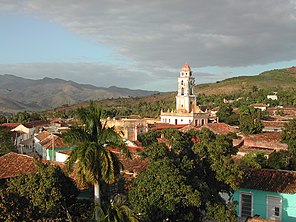 The Iglesia y Convento de San Francisco in Trinidad | |
Location of Trinidad in Cuba | |
| Coordinates: 21°48′15″N 79°58′59″W / 21.80417°N 79.98306°W | |
| Country | |
| Province | Sancti Spíritus |
| Founded | December 23, 1514[266] |
| Area | |
• Total | 1,155 km2 (446 sq mi) |
| Elevation | 80 m (260 ft) |
| Population (2004)[258] | |
• Total | 73,466 |
| • Density | 63.6/km2 (165/sq mi) |
| Time zone | UTC-5 (EST) |
| Area code | +53-41 |
From Cienfuegos - about an hour, just stay by the coast most of the way. Not all turns are signposted.
Trinidad is a town in the province of Sancti Spíritus, central Cuba. Together with the nearby Valle de los Ingenios, it has been one of UNESCOs World Heritage sites since 1988.
History
[edit]Trinidad was founded on December 23, 1514[266] by Diego Velázquez de Cuéllar under the name Villa De la Santísima Trinidad. Francisco Iznaga, a rich Basque landowner in the southern portion of Cuba during the first 30 years of the colonization of Cuba, was elected Mayor of Bayamo in 1540.Iznaga was the originator of a powerful lineage that finally settled in Trinidad where the Torre Iznaga is. His descendents fought for the Independence of Cuba and the Annexation to the US from 1820 to 1900. It is one of the best preserved cities in the Caribbean from the time when the sugar trade was the main industry in the region.
Economy
[edit]Nowadays, Trinidad's main industry is tobacco processing. The older parts of town are well preserved as the Cuban tourism industry sees benefit from tour groups. In contrast, some parts of town outside the non-tourist areas are very run down and in disrepair, especially in the centre.
Tourism
[edit]Tourism officials like to say Trinidad is a museum in itself. Those visiting the 500-year-old city will find Spanish colonial architecture, underscoring a colonial ambiance that marks the tiny city one of the country’s greatest attractions. Only a few square blocks in size, historic Trinidad is famous for its lovely, cobblestone streets, pastel coloured houses with elaborate wrought-iron grills, as well as beautiful palaces and plazas. The city can be toured in a few hours, by foot or by horse-drawn carriage. The city is located near both the Escambray Mountains and the Caribbean coast.
One of the area’s interesting sights is the Valley of the Sugar Mills, which has been declared a World Heritage Site. The valley has around 70 long-standing sugar mills which are a reminder of the importance of sugar to the Cuban economy over the centuries. It has la Torre Iznaga, a 45 meter tower built by Alejo Iznaga Borrell in 1816. Twenty km from the city is Topes de Collantes, one of Cuba’s premier ecotourism centres. Another attraction is the Casilda Bay, which attracts both snorkelers and divers. A nearby islet has pristine beaches.
Ancon Beach is a white sand beach which was one of the first new resorts to be developed in Cuba following the 1959 revolution. Along the Ancon Peninsula are three hotels: Hotel Costa Sur (South Coast Hotel), Hotel Ancon and Brisas Trinidad del Mar (opened in 2002)
There are several world class casas de musica, and every night next to the church in plaza major is one of Cuba's busiest dance floors. There are also excellent discotheques, one in a church ruins the other in a huge cave once used as a war time hospital.
Attractions
[edit]- Plaza Mayor
- Municipal History Museum
- Santísima Trinidad Cathedral
- Playa Ancon
- Plaza Mayor: Attraction type: Landmarks/ Points of Interest |
- Romance Museu: Attraction type: Specialty Museums
- Trinidad Architecture Museum
- Iglesia Parroquial de la Santisima Trinidad: Built between 1817 and 1892 and now being restored, it is the largest church in Cuba. Address: Located off the Plaza Mayor, Trinidad, Cuba
Demographics
[edit]In 2004, the municipality of Trinidad had a population of 73,466.[258] With a total area of 1,155 km2 (446 sq mi),[229] it has a population density of 63.6/km2 (165/sq mi).
The municipality is divided into the barrios of Primero, Segundo, Tercero, Aguacate, Cabagán, Caracusey, Casilda, Guaniquical, Río de Ay, San Francisco, San Pedro and Táyaba.[266]
Photo gallery
[edit]Eat
[edit]Paladar San Jose
[edit]Address: Maceo No. 382 E, Trinidad, Cuba
Tel: +53(0)41 994702
Paladar Sol y Son
[edit]Price range*: $1–36
Cuisine: Fusion
Recommended For: Romance
Address: Simon Bolivar 283 | btwn Frank País & José Martí, Trinidad, Cuba
Tel: 05341992926
Plaza Mayor Restaurant
[edit]Address: Calle Ruben Martinez Villena, Trinidad, Cuba
Tel: +53(0)419 3180
Sancti Spíritus
[edit]Sancti Spíritus | |
|---|---|
 Yayabo Bridge over the Yayabo River som suger | |
Location of Sancti Spíritus in Cuba | |
| Coordinates: 21°56′2″N 79°26′38″W / 21.93389°N 79.44389°W | |
| Country | |
| Province | Sancti Spíritus |
| Founded | 1514[266] |
| Area | |
• Total | 1,151 km2 (444 sq mi) |
| Elevation | 75 m (246 ft) |
| Population (2004)[258] | |
• Total | 133,843 |
| • Density | 116.3/km2 (301/sq mi) |
| Time zone | UTC-5 (EST) |
| Area code | +53-41 |
Sancti Spíritus is a municipality and capital city of the province of Sancti Spíritus in central Cuba. Sancti Spíritus, Latin for "Holy Spirit," is one of the best preserved cities in the Caribbean from the time of the sugar trade.
History
[edit]
The city was founded by Diego Velázquez de Cuéllar in 1514.[266] Francisco Iznaga, a rich Basque landowner in the western portion of Cuba during the first thirty years of the colonization of Cuba, was elected mayor of Bayamo in 1540. Iznaga was the originator of a powerful lineage that finally settled in Sancti Spiritus and Trinidad where Torre Iznaga is. Iznaga's descendants fought for the Independence of Cuba and the Annexation to the US from 1820 to 1900.
The Parroquial Mayor is located two blocks south of the town's main square; it is a venerable green-towered church whose early 16th-century origins make it the country's oldest. Nearby is the Museo de Arte Colonial (Colonial Art Museum), one of Sancti Spíritus's most splendid colonial homes and a standout attraction. The opulent former palatial mansion of the Valle Iznaga clan, one of Cuba's most elite families who fled Cuba after Fidel's Revolution, it became the property of the state in 1961. Ninety percent of what you see inside, from furniture to paintings, is original. Though the family obviously kept an impressive collection of Limoges porcelain, French gilded mirrors, Italian marble tables, and Baccarat crystal chandeliers here, it wasn't their primary residence; the house was used mostly to host family members in transit, so the furnishings were rather eclectic. The three bedrooms are decorated in grand style, though, with handmade lace, embroidered sheets, and hand-painted glass. There is a gorgeous and very Cuban leather sillón fumador (smoking chair) and, in the music room, the mid-18th-century American piano, one of only two of its type in Cuba. In the tearoom is the family seal, which says a lot about the arrogance of the rich and powerful: "El que más vale no vale tanto como Valle vale" ("He who has the greatest worth isn't worth as much as a Valle is worth" -- playing off the Spanish word for "worth" with the family surname).
Another interesting landmark is one of Cuba's older bridges over the Yayabo river. Built in 1815 with clay bricks it forms five arcs, the center being 9 meters tall. The entire bridge is only 85 meters long and was designed for pedestrians and carriages during colonial-era Cuba but has thus far resisted heavier modern traffic.
Sancti Spíritus has a worldwide famous Medical University located at the Main road in Olivos III. It has students from all over the world representing 34 nationalities. Recently 311 Pakistani students were enrolled in the University. Now the major part of the students comprises over Pakistani Medical Students.
It is also the home of the Sancti Spíritus Gallos baseball team.
Geography
[edit]The municipality is divided into the barrios of Banao, Bellamota, Bijabo, Guasimal, Guayos, Hospital, Jíbaro, Manacas, Mapos, Paredes, Paula, Pelayo, Pueblo Nuevo, San Andrés, Tuinicú, Tunas de Zaza and Zaza del Medio.[266]
The Zaza Reservoir is located southwest of the city.
The city has a central park which is a place of great entertainment for the persons of all ages.
Demographics
[edit]In 2004, the municipality of Sancti Spíritus had a population of 133,843.[258] With a total area of 1,151 km2 (444 sq mi),[229] this means a population density of 116.3/km2 (301/sq mi).
Sancti Spíritus
[edit]Sancti Spíritus | |
|---|---|
 Yayabo Bridge over the Yayabo River som suger | |
Location of Sancti Spíritus in Cuba | |
| Coordinates: 21°56′2″N 79°26′38″W / 21.93389°N 79.44389°W | |
| Country | |
| Province | Sancti Spíritus |
| Founded | 1514[266] |
| Area | |
• Total | 1,151 km2 (444 sq mi) |
| Elevation | 75 m (246 ft) |
| Population (2004)[258] | |
• Total | 133,843 |
| • Density | 116.3/km2 (301/sq mi) |
| Time zone | UTC-5 (EST) |
| Area code | +53-41 |
Sancti Spíritus is a municipality and capital city of the province of Sancti Spíritus in central Cuba. Sancti Spíritus, Latin for "Holy Spirit," is one of the best preserved cities in the Caribbean from the time of the sugar trade.
History
[edit]
The city was founded by Diego Velázquez de Cuéllar in 1514.[266] Francisco Iznaga, a rich Basque landowner in the western portion of Cuba during the first thirty years of the colonization of Cuba, was elected mayor of Bayamo in 1540. Iznaga was the originator of a powerful lineage that finally settled in Sancti Spiritus and Trinidad where Torre Iznaga is. Iznaga's descendants fought for the Independence of Cuba and the Annexation to the US from 1820 to 1900.
The Parroquial Mayor is located two blocks south of the town's main square; it is a venerable green-towered church whose early 16th-century origins make it the country's oldest. Nearby is the Museo de Arte Colonial (Colonial Art Museum), one of Sancti Spíritus's most splendid colonial homes and a standout attraction. The opulent former palatial mansion of the Valle Iznaga clan, one of Cuba's most elite families who fled Cuba after Fidel's Revolution, it became the property of the state in 1961. Ninety percent of what you see inside, from furniture to paintings, is original. Though the family obviously kept an impressive collection of Limoges porcelain, French gilded mirrors, Italian marble tables, and Baccarat crystal chandeliers here, it wasn't their primary residence; the house was used mostly to host family members in transit, so the furnishings were rather eclectic. The three bedrooms are decorated in grand style, though, with handmade lace, embroidered sheets, and hand-painted glass. There is a gorgeous and very Cuban leather sillón fumador (smoking chair) and, in the music room, the mid-18th-century American piano, one of only two of its type in Cuba. In the tearoom is the family seal, which says a lot about the arrogance of the rich and powerful: "El que más vale no vale tanto como Valle vale" ("He who has the greatest worth isn't worth as much as a Valle is worth" -- playing off the Spanish word for "worth" with the family surname).
Another interesting landmark is one of Cuba's older bridges over the Yayabo river. Built in 1815 with clay bricks it forms five arcs, the center being 9 meters tall. The entire bridge is only 85 meters long and was designed for pedestrians and carriages during colonial-era Cuba but has thus far resisted heavier modern traffic.
Sancti Spíritus has a worldwide famous Medical University located at the Main road in Olivos III. It has students from all over the world representing 34 nationalities. Recently 311 Pakistani students were enrolled in the University. Now the major part of the students comprises over Pakistani Medical Students.
It is also the home of the Sancti Spíritus Gallos baseball team.
Geography
[edit]The municipality is divided into the barrios of Banao, Bellamota, Bijabo, Guasimal, Guayos, Hospital, Jíbaro, Manacas, Mapos, Paredes, Paula, Pelayo, Pueblo Nuevo, San Andrés, Tuinicú, Tunas de Zaza and Zaza del Medio.[266]
The Zaza Reservoir is located southwest of the city.
The city has a central park which is a place of great entertainment for the persons of all ages.
Demographics
[edit]In 2004, the municipality of Sancti Spíritus had a population of 133,843.[258] With a total area of 1,151 km2 (444 sq mi),[229] this means a population density of 116.3/km2 (301/sq mi).
Bayamo
[edit]Bayamo | |
|---|---|
Location of Bayamo in Cuba | |
| Coordinates: 20°22′54″N 76°38′34″W / 20.38167°N 76.64278°W | |
| Country | |
| Province | Granma |
| Established | November 15, 1513[266] |
| Incorporated | 1827 (city) |
| Area | |
• Total | 918 km2 (354 sq mi) |
| Elevation | 55 m (180 ft) |
| Population (2004)[258] | |
• Total | 222,118 |
| • Density | 242.0/km2 (627/sq mi) |
| Time zone | UTC-5 (EST) |
| Area code | +53-23 |
Bayamo is the capital city of the Granma Province of Cuba, and one of the largest cities in the Oriente region.
The community of Bayamo lies on a plain by the Bayamon River. It is affected by the violent Bayamo wind.
One of the most important education institutions in the province is the University of Granma.
History
[edit]Bayamo was the second of the seven cities founded by Diego Velázquez de Cuéllar, and was established on November 5, 1513. Francisco Iznaga, a rich Basque landowner in the western portion of Cuba during the first 30 years of the colonization of Cuba, was elected Mayor in 1540.Iznaga was the originator of a powerful lineage that finally settled in Trinidad where the Torre Iznaga is. His descendents fought for the Independence of Cuba and the Annexation to the US from 1820 to 1900.
During much of the 16th century it was one of the most important agricultural and commercial settlements of the island. Its inland situation gave it relative security against the pirates who then infested West Indian seas, and the misfortunes of Santiago were the fortunes of Bayamo. Down the Cauto River, then open to the sea for vessels of 200 tons, and through Manzanillo, Bayamo drove a thriving contraband trade that made it at the opening of the 17th century the leading town of Cuba.
A tremendous flood, in 1616, choking the Cauto with trees and wrecked vessels, cut if off from direct access to the sea; but through Manzanillo it continued a great clandestine traffic with Curaçao, Jamaica, and other foreign islands throughout the 17th and 18th centuries. Bayamo was then surrounded by fine plantations.
In 1827 it acquired the status of city. In the war of 1868–1878 it was an insurgent stronghold; near it was fought one of the most desperate conflicts of the war, and it was nearly destroyed by the opposing parties.
Demographics
[edit]In 2004, the municipality of Bayamo had a population of 222,118.[258] With a total area of 918 km2 (354 sq mi),[229] it has a population density of 242.0/km2 (627/sq mi).
Transportation
[edit]Bayamo is an under recognized world leader in sustainable transportation. Per a UN study only about 15% of commuters rely on motorized transport and almost three times as many (39%) rely on about 500 licensed horse drawn carriages generally following fixed routes. The rest of the non-pedestrian traffic is bicycle and bicycle taxi.[269][270]
Notable residents
[edit]- Francisco Vicente Aguilera (1821–1877), revolutionary.
- Conrado Roblejo Aguilera (born 1966), doctor
- José Antonio Cedeño (born 1939), artist.
- Carlos Manuel de Céspedes (1819–1874), revolutionary.
- Perucho Figueredo (1818–1870), composer of the Cuban national anthem
- Pablo Milanés (born 1943), singer.
- Tomás Estrada Palma (1832–1908), President of Cuba.
- Felo Ramírez (born 1921), radio presenter
- Rolando Uríos (born 1971), Handball player.
Santiago de Cuba
[edit]Santiago de Cuba | |
|---|---|
Location of Santiago de Cuba in Cuba | |
| Coordinates: 20°01′11.4″N 75°48′50.1″W / 20.019833°N 75.813917°W | |
| Country | Cuba |
| Province | Santiago de Cuba |
| Established | 1515 |
| Area | |
• Total | 1,023.8 km2 (395.3 sq mi) |
| Elevation | 82 m (269 ft) |
| Population (2004)[258] | |
• Total | 472,255 |
| • Density | 461.3/km2 (1,195/sq mi) |
| Area code | +53-22 |
| Website | Santiago.cu |
Santiago de Cuba is the second largest city of Cuba and capital city of Santiago de Cuba Province in the south-eastern area of the island, some 540 miles (870 km) south-east of the Cuban capital of Havana.
The municipality extends over 1,023.8 square kilometers (395.3 sq mi),[271] and contains the communities of El Caney, Guilera, Antonio Maceo, Bravo, Castillo Duany, Leyte Vidal and Moncada.[266]
Historically Santiago de Cuba has long been the second most important city on the island after Havana, and still remains the second largest. It is on a bay connected to the Caribbean Sea and is an important sea port. In 2004 the city of Santiago de Cuba had a population of about 494,337 people.[272]
History
[edit]Santiago de Cuba was founded by Spanish conquistador Diego Velázquez de Cuéllar on June 28, 1514. In 1516 the settlement was destroyed by fire, and was immediately rebuilt. This was the starting point of the expeditions led by Juan de Grijalba and Hernán Cortés to the coasts of Mexico in 1518, and in 1538 by Hernando de Soto's expedition to Florida. The first cathedral was built in the city in 1528. From 1522 until 1589 Santiago was the capital of the Spanish colony of Cuba.
The city was plundered by French forces in 1553, and by British forces under Christopher Myngs in 1662.
The city experienced an influx of French immigrants in the late 18th century and early 19th century, many coming from Haiti after the Haitian slave revolt of 1791. This added to the city's eclectic cultural mix, already rich with Spanish and African culture.
It was also the location where Spanish troops faced their main defeat at San Juan Hill on July 1, 1898, during the Spanish-American War. Spain later surrendered to the United States after the destruction of its Atlantic fleet just outside Santiago's harbor.
Cuban poet, writer, and national hero, José Martí, is buried in Cementerio Santa Efigenia.
Role in the Cuban Revolution
[edit]Santiago was also the home of the revolutionary hero, Frank País. On July 26, 1953, the Cuban Revolution began with an ill-prepared armed attack on the Moncada Barracks by a small contingent of rebels led by Fidel Castro. Shortly after this disastrous incident, País began talking with students and young working people informally, drawing around him what became an extremely effective urban revolutionary alliance. This developed into highly organized cells coordinating a large scale urban resistance that became instrumental in the success of the Cuban Revolution.[273]
País' group prepared carefully, accruing weapons, collecting money, collecting medical supplies. They published a cheap newsletter that reported news that criticized the government, attempting to counter Batista's censorship.[274]
In the summer of 1955, País’ organization merged with Castro's July 26 Movement. País became the leader of the new organization in Oriente province.
On January 1, 1959, Fidel Castro proclaimed the victory of the Cuban Revolution from a balcony on Santiago de Cuba's city hall.
Culture
[edit]| UNESCO World Heritage Site | |
|---|---|
 | |
| Criteria | Cultural: iv, v |
| Reference | 841 |
| Inscription | 1997 (21st Session) |
Santiago de Cuba was the hometown of poet José María Heredia. It houses a museum that displays the extensive art collection of the Bacardí family.
Santiago de Cuba is well known for its cultural life. Some of Cuba's most famous musicians, including Compay Segundo, Ibrahim Ferrer and Eliades Ochoa (all of whom participated in the Buena Vista Social Club) and trova composer Ñico Saquito (Benito Antonio Fernández Ortiz) were born in the city or in one of the villages surrounding it. They have contributed to the typical, country-like music of the city.
Furthermore, Santiago de Cuba is well-known for its traditional dances, most notably son, from which salsa has been derived, and guaguancó, which is accompanied by percussion music only. The city is also well-known for its Carnival, which is strangely enough celebrated in July. During Carnival, traditional conga music is played in the streets on a traditional pentatonic trumpet, called the trompeta china.
A relatively high number of residents of the city adhere to Afro-Cuban religions, most notably santería. The city hosts an important community of descendants from Haitian immigrants from the 19th century. Some aspects of the religious "vodún" heritage of the city can be traced back to this community.
In the city there are multiple architectural styles, from Baroque to neoclassical. Of special interest are the wooded parks, the steep streets, colonial buildings with huge windows and crowded balconies. Preserved historical treasures include the first home in the Americas, the first cathedral in Cuba, the first copper mine opened in the Americas and the first Cuban museum.
World Heritage Site
[edit]The local citadel of San Pedro de la Roca is inscribed on the UNESCO World Heritage List as "the most complete, best-preserved example of Spanish-American military architecture, based on Italian and Renaissance design principles".[275]
World Heritage Biosphere Reserve
[edit]The Baconao Park was inscribed on the UNESCO World Heritage Biosphere Reserve List in 1987.[276]
Geography
[edit]Santiago de Cuba is located in the southeast of the island at coordinates 20 ° 01'17 .42 "N 75 ° 49'45 .75" O, some 540 miles (870 km) of the capital, Havana. Historically Santiago de Cuba has been the second largest city in Cuba, behind Havana. It features a bay connected to the Caribbean Sea and is a major port. The municipality of Santiago de Cuba, where is its capital city, is the most populated of Cuba.
The city has been growing at the bottom of the bay and is surrounded on land by the Sierra Maestra. This determines the hot and humid climate of the place, the landscapes features rich composition of urban elements, natural and marine at the same time. It has an irregular offset, which contributed to the development of an urban setting where the avenues and streets are steep or descend.
Climate
[edit]| Climate data for Santiago de Cuba | |||||||||||||
|---|---|---|---|---|---|---|---|---|---|---|---|---|---|
| Month | Jan | Feb | Mar | Apr | May | Jun | Jul | Aug | Sep | Oct | Nov | Dec | Year |
| Mean daily maximum °F (°C) | 82 (28) |
82 (28) |
82 (28) |
83 (28) |
84 (29) |
86 (30) |
87 (31) |
87 (31) |
87 (31) |
86 (30) |
86 (30) |
83 (28) |
85 (29) |
| Mean daily minimum °F (°C) | 70 (21) |
70 (21) |
71 (22) |
73 (23) |
74 (23) |
76 (24) |
77 (25) |
77 (25) |
76 (24) |
75 (24) |
73 (23) |
71 (22) |
74 (23) |
| Average precipitation inches (mm) | 2.90 (74) |
1.70 (43) |
2.10 (53) |
2.30 (58) |
5.50 (140) |
4.00 (102) |
2.70 (69) |
3.70 (94) |
4.20 (107) |
7.60 (193) |
3.70 (94) |
3.20 (81) |
43.6 (1,108) |
| Source: weather.com[277] | |||||||||||||
Demographics
[edit]In 2004, the municipality of Santiago de Cuba had a population of 494,337.[258] With a total area of 1,024 km2 (395 sq mi), it has a population density of 482.8/km2 (1,250/sq mi).
| 1861 | 1899 | 1907 | 1919 | 1931 | 1943 | 1953 | ||||
|---|---|---|---|---|---|---|---|---|---|---|
| 36.752 | 43.090 | 45.470 | 62.083 | 101.508 | 118.266 | 163.237 | ||||
| 1970 | 1981 | 2002 | 2003 | 2004 | 2005 | 2006 | ||||
| 277.600 | 347.279 | 423.392 | 424.031 | 424.905 | 425.780 | 426.199 | ||||
| 2007 | 2008 | 2009 | ||||||||
| 426.618 | 426.679 | 446.233 | ||||||||
| Census until 2002; between 2003 and 2009 are estimates | ||||||||||
Transportation
[edit]Santiago is served by Antonio Maceo Airport. Cubana de Aviación connects the city with Havana, Montréal, Madrid and Paris-Orly, other airlines connect the city with the rest of the Caribbean and North America.
The public transit in the city, like Havana, is carried out by two divisions, Omnibus Metropolitanos (OM) and Metrobus.[226] The Metrobus serves the inner-city urban area, with a maximum distance of 20 km.[226] Omnibus Metropolitanos (OM) connects the adjacent towns and municipalities in the metropolitan area with the city center, with a maximum distance of 40 km.[226]
Ferrocarriles de Cuba railways and ASTRO inter-city buses connect the city with Havana's Central Railway Station and with most other main cities of Cuba.
Schools
[edit]The main secondary education institution is the University of Santiago de Cuba (Universidad de Oriente - Santiago de Cuba, UO).
Natives and residents
[edit]- Desi Arnaz - television/film actor, producer and bandleader
- Emilio Bacardí - industrialist and philanthropist
- Orestes Destrade -professional baseball Player
- Emilio Estefan - music producer and husband of singer Gloria Estefan
- Ibrahim Ferrer - musician
- Sindo Garay - musician
- José María Heredia y Heredia - poet
- Pancho Herrera- professional baseball player
- Alberto Juantorena - Olympic gold medallist, 1976 Olympics
- Faizon Love - television/film actor, comedian
- Konnan - professional wrestler
- Olga Guillot - singer
- La Lupe - salsa singer
- Antonio Maceo Grajales - independence hero
- Rita Marley- singer and wife of reggae singer Bob Marley
- José Martí - independence hero; interred in Santiago de Cuba
- Miguel Matamoros - musician
- Eliades Ochoa - musician
- Frank Pais - revolutionary and urban organizer for the 26th of July Movement
- Jorge Reyes - author
- Esteban Salas y Castro - Baroque composer
- Ñico Saquito (Benito Antonio Fernández Ortiz) - musician and trova composer
- Compay Segundo - musician
Varadero
[edit]Varadero | |
|---|---|
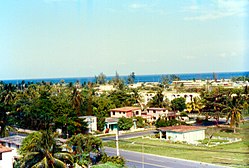 Town of Varadero | |
| Nickname: Playa Azul (Blue Beach) | |
Location of Varadero in Cuba | |
| Coordinates: 23°08′22″N 81°17′10″W / 23.13944°N 81.28611°W | |
| Country | |
| Province | Matanzas |
| Founded | December 5, 1887 |
| Established | July 3, 1976 (Municipality) |
| Area | |
| 32 km2 (12 sq mi) | |
| Elevation | 4 m (13 ft) |
| Population (2007)[278] | |
| aprox. 20,000 | |
| • Density | 771.3/km2 (1,998/sq mi) |
| • Urban | 20,000 |
| Time zone | UTC-5 (EST) |
| Area code | +53-45 |
Varadero is a resort town in the province of Matanzas, Cuba, and one of the largest resort areas in the Caribbean. Varadero is also called Playa Azul, which means "blue beach" in Spanish.
Geography
[edit]It is situated on the Hicacos Peninsula, between the Bay of Cárdenas and the Straits of Florida, some 140 km east of Havana, at the eastern end of the Via Blanca highway. The peninsula is only 1.2 km wide at its widest point and is separated from the island of Cuba by the Kawama Channel. This spit of land however extends more than 20 kilometers from the mainland in a northeasterly direction and its tip, Punta Hicacos, is the northernmost point of the island of Cuba. At the northeastern end of the peninsula there is a nature reserve with virgin forests and beaches. The Hicacos Point Natural Park is a 3.12 km2 (1.20 sq mi) ecological preserve established in 1974. It contains the 250 m (820 ft) long Cave of Ambrosio, Mangón Lake (home to 31 species of birds and 24 species of reptiles) and the ruins of the La Calavera (The Skull) Salt Works (one of the first salt works to be constructed by the Spanish in the New World).[279] The cays developed off shore, such as Cayo Piedras and Cayo Cruz del Padre are the western most part of the Sabana-Camaguey Archipelago.
Juan Gualberto Gómez Airport, situated west of the peninsula, is Varadero's airport. It is the second-most-important airport of the island after José Martí Airport in Havana, and serves international and domestic flights.
History
[edit]
The first mention of Varadero was in 1555.[280] The place was first used as a dry dock (Spanish: varadero) and the salt mines of the peninsula (closed in 1961) supplied most of the Spanish Latin America Fleet since 1587. However, the foundation date of Varadero as city was only on December 5, 1887, when ten families from the city of Cárdenas obtained a permission to build their vacation homes between today's 42nd and 48th Street.
It was established as municipality (Spanish: municipio) at the administrative re-distribution of July 3, 1976[281] from territories previously part of Cárdenas. In August 2010, the Varadero municipality was abolished according to a Law approved by the Cuban National Assembly, becoming again part of the Cárdenas municipality.
Tourism
[edit]
Varadero is foremost a tourist resort town, boasting more than 20 km of white sandy beaches. The first tourists visited Varadero as early as the 1870s, and for years it was considered an elite resort. In 1910 the annual rowing regatta was started; five years later the first hotel, named Varadero and later Club Nautico, was built. Tourism grew in the early 1930s as Irénée du Pont Nemours, an American millionaire, built his estate on the peninsula. Many famous and infamous people stayed in Varadero, for example Al Capone.[282]
After the Cuban Revolution in 1959, many mansions were expropriated from their rich owners. These mansions soon became museums.[citation needed] As a symbol of the new integrated tourism for Cubans and foreign visitors of all social classes, the Park of the 8000 Cubicles (Parque de las 8000 Taquillas) was built in 1960. Visitors could leave their belongings in the basement of the park, had access to sanitary installations and gastronomic services on the first floor, and could rent bathing articles and swimsuits. The surroundings of the park became the center of the city. Between the 1960s and 1980s Varadero transformed itself into a cultural centre. During those years the central park (8000 Taquillas) (located between 44th and 46th Street) saw countless concerts, festivals and sporting events.[283]
The 1990s brought the start of another hotel building campaign, mostly in the 4-star and 5-star segment. Many of the hotels are operated or co-owned by foreign businesses like Melia, Barcelo, TRYP, etc. (France's Club Med used to have a property but has since left Varadero.) As international tourism was opened up, the local population expanded with the arrival of people, some in key economic positions, from other parts of Cuba. As a consequence, Varadero has lost much of its social and cultural life and its traditions. The central park, the cinema and various cultural meeting places were neglected in favor of a hotel-centred all-inclusive-tourism and finally closed. The International Carnival, an initiative of Cubans and foreigners started in the 1980s, also ceased.
In addition to its most valued resource, the beach, Varadero has natural attractions such as caves and a chain of easily accessed virgin cays. There are also cultural, historical and environmental attractions in the vicinity, such as the cities of Matanzas and Cárdenas, the Zapata Peninsula and the resort of San Miguel de los Baños. Varadero, which is a free port, also possesses facilities for scuba diving, deep-sea fishing, yachting and other water sports.
Varadero receives more than 1 million tourists annually.[citation needed]
Varadero is primarily visited by European and Canadian tourists. The number of U.S. tourists visiting Varadero, although increasing, has been limited because of the U.S. government restrictions that make it difficult, but not illegal for U.S. citizens to visit Cuba as tourists.
Demographics
[edit]
In 2007, the municipality of Varadero had a population of about 20,000 between the Hicacos peninsula (7,000) and the two incorporated localities of Santa Marta and Boca de Camarioca.[284] With a total area of 32 km2 (12 sq mi),[229] it has a population density of 771.3/km2 (1,998/sq mi). Starting from January 2011, the Varadero municipality was abolished and incorporated into the neighbor municipality of Cardenas. Therefore, Varadero is now only acknowledged as the region in the Hicacos peninsula, properly the beach area.
References
[edit]- ^ "Cuban Peso Bills". Central Bank of Cuba. Retrieved 2009-09-07.
- ^ "National symbols". Government of Cuba. Retrieved 2009-09-07.
- ^ a b c "Census of population and homes" (in Spanish). Government of Cuba. 16 September 2002. Retrieved 2009-09-07.
- ^ Government type (most recent) by country, Nationmaster.com
- ^ a b c d Anuario Estadístico de Cuba 2009. Edición 2010, Oficina Nacional de Estadísticas, República de Cuba. Accessed on November 6, 2010. Note: An exchange rate of 1 CUC to 1.08 USD was used to convert GDP.[1]
- ^ a b c "Cuba". The World Factbook. CIA. Retrieved 2009-04-06.
- ^ http://hdr.undp.org/en/media/HDR_2009_EN_Complete.pdf
- ^ From 1993 to 2004 the United States dollar was used alongside the peso until the dollar was replaced by the convertible peso
- ^ Thomas, Hugh (March 1971). Cuba; the Pursuit of Freedom. New York: Harper & Row. ISBN 0060142596.
- ^ Thomas, Hugh (1997). The Slave Trade: The Story of the Atlantic Slave Trade, 1440–1870. New York, NY: Simon & Schuster. ISBN 0684835657.
- ^ "Remarks of Senator John F. Kennedy at Democratic Dinner, Cincinnati, Ohio". John F. Kennedy Presidential Library & Museum – Jfklibrary.org. 1960-10-06. Retrieved 2010-11-07.
- ^ a b c https://www.cia.gov/library/publications/the-world-factbook/geos/cu.html Cite error: The named reference "autogenerated1" was defined multiple times with different content (see the help page).
- ^ a b "unstats | Millennium Indicators". Mdgs.un.org. 2010-06-23. Retrieved 2010-11-07.
- ^ CIA World Factbook
- ^ untitled
- ^ Alfred Carrada, The Dictionary of the Taino Language (plate 8)[unreliable source?]
- ^ Dictionary – Taino indigenous peoples of the Caribbean Dictionary --[unreliable source?]
- ^ Augusto Mascarenhas Barreto: O Português. Cristóvão Colombo Agente Secreto do Rei Dom João II. Ed. Referendo, Lissabon 1988. English: The Portuguese Columbus: secret agent of King John II, Palgrave Macmillan, ISBN 0-333-56315-8
- ^ da Silva, Manuel L. and Silvia Jorge da Silva. (2008). Christopher Columbus was Portuguese, Express Printing, Fall River, MA. 396pp. ISBN 9781607028246.
- ^ Ramón Dacal Moure, Manuel Rivero de la Calle (1996). Art and archaeology of pre-Columbian Cuba. University of Pittsburgh Press. p. 22. ISBN 082293955X.
- ^ "Taino Name for the Islands". Indio.net. Retrieved 2010-11-07.
- ^ a b Ted Henken (2008). Cuba: a global studies handbook. ABC-CLIO. p. 30. ISBN 9781851099849. (gives the landing date in Cuba as October 27)
- ^ Cuba Oficina Del Censo (2009). Cuba: Population, History and Resources 1907. BiblioBazaar, LLC. p. 28. ISBN 9781110288182. (gives the landing date in Cuba as October 28)
- ^ These are Julian calendar dates.
- ^ Gott, Richard (2004). Cuba: a new history. New Haven, Conn.: Yale University Press. p. 13. ISBN 0300104111.
- ^ Andrea, Alfred J. (2005). "Letter by Christopher Columbus concerning recently discovered islands". The Human Record. Vol. 1. Houghton Mifflin Company. p. 8. ISBN 0618370404.
{{cite book}}: Unknown parameter|coauthors=ignored (|author=suggested) (help) - ^ Diamond, Jared M. (1998). Guns, Germs, and Steel: The Fates of Human Societies. New York, NY: W.W. Norton & Co. ISBN 0393038912.
- ^ Byrne, Joseph Patrick (2008). Encyclopedia of Pestilence, Pandemics, and Plagues: A-M. ABC-CLIO. p. 413. ISBN 978-0313341021.
- ^ J. N. Hays (2005). "Epidemics and pandemics: their impacts on human history". p.82. ISBN 1851096582
- ^ Latin America's Wars: The age of the caudillo, 1791–1899. Robert L. Scheina (2003). p.352. ISBN 1574884506
- ^ Chomsky, Carr & Smorkaloff 2003, pp. 115–117.
- ^ "Historia de las Guerras de Liberación de Cuba".[unreliable source?]
- ^ "The Little War (La Guerra Chiquita)".[unreliable source?]
- ^ Rebecca Jarvis Scott (2000). Slave emancipation in Cuba: the transition to free labor, 1860–1899. University of Pittsburgh Pre. p. pg=PA3 3. ISBN 9780822957355.
- ^ Chomsky, Aviva; Carr, Barry; Smorkaloff, Pamela María (2003). The Cuba reader: history, culture, politics. Duke University Press. pp. 37–38. ISBN 9780822331971.
- ^ a b c d Stanley Sandler, ed. (2002). Ground warfare: an international encyclopedia. Vol. Part 25, Volume 1. ABC-CLIO. p. 549. ISBN 1576073440. Retrieved 2009-09-06.
- ^ a b David Arias (2005). Spanish-americans: Lives And Faces. Victoria, BC, Canada: Trafford Publishing. p. 171. ISBN 141204717X. Retrieved 2009-09-06.
- ^ Robert K. Home (1997). Of Planting and Planning: The Making of British Colonial Cities. Chapman and Hall. p. 195. ISBN 0419202307. Retrieved 2009-09-06.
- ^ The Spanish-American War. "Cuban Reconcentration Policy and its Effects". Retrieved 2007-01-29.[unreliable source?]
- ^ a b c Morison, Samuel Loring (2003). The American Battleship. St. Paul, Minn.: MBI Publishing Company. p. 18. ISBN 0760309892. Retrieved 2009-09-15.
{{cite book}}: Unknown parameter|coauthors=ignored (|author=suggested) (help) - ^ Rickover, Hyman George (1994). How the Battleship Maine Was Destroyed. Annapolis, Md.: Naval Institute Press. ISBN 1557507171.
- ^ Potter, Elmer Belmont (1981). Sea Power: a Naval History. Annapolis, Md.: United States Naval Institute. p. 176. ISBN 0870216074. Retrieved 2009-09-15.
{{cite book}}: Unknown parameter|coauthors=ignored (|author=suggested) (help) - ^ Macdonald, William (1908). Documentary Source Book of American History, 1606–1898. New York, NY: Macmillan Co. p. 597. ISBN 9781406763454. Retrieved 2009-09-14.
- ^ "Treaty of Peace Between the United States and Spain". The Avalon Project. Yale Law School. December 10, 1898.
- ^ Diaz-Briquets, Sergio (2006). Corruption in Cuba: Castro and Beyond. Austin: University of Texas Press. p. 63. ISBN 0292713215. Retrieved 2009-09-06.
{{cite book}}: Unknown parameter|coauthors=ignored (|author=suggested) (help) - ^ Thomas, Hugh (March 1971). Cuba: the Pursuit of Freedom. New York: Harper & Row. pp. 283–287. ISBN 0060142596.
- ^ Benjamin Beede, ed. (1994). The War of 1898, and U.S. interventions, 1898–1934: an encyclopedia. New York: Garland. p. 134. ISBN 0824056248. Retrieved 2009-09-06.
- ^ Argote-Freyre, Frank (2006). Fulgencio Batista. Vol. 1. New Brunswick, N.J.: Rutgers University Press. p. 50. ISBN 0813537010.
- ^ a b c d Bethell, Leslie (1993). Cuba. Cambridge University Press. ISBN 0521436823.
{{cite book}}: Check|isbn=value: checksum (help) - ^ Julia E. Sweig (2004). Inside the Cuban Revolution. Cambridge, Mass.: Harvard University Press. ISBN 0674016125.
{{cite book}}: Check|isbn=value: checksum (help) - ^ a b c d e Horowitz, Irving Louis (1988). Cuban communism. New Brunswick, N.J.: Transaction Books. p. 662. ISBN 0887386725.
- ^ Julia E. Sweig (2004). Inside the Cuban Revolution. Cambridge, Mass.: Harvard University Press. ISBN 9780674016125.
- ^ Jorge I. Domínguez (1978). Cuba. ISBN 0674179250.
- ^ "Batista's Boost", Time, January 18, 1943. Retrieved March 2, 2010.
- ^ José Alvarez (2004). "Cuban Agriculture Before 1959: The Social Situation". Cuba's Agricultural Sector (PDF). University Press of Florida. ISBN 0813027543. Retrieved 2008-01-08.
- ^ Remarks of Senator John F. Kennedy at Democratic Dinner, Cincinnati, Ohio, October 6, 1960 from the John F. Kennedy Presidential Library
- ^ a b c d e f g h Paul H. Lewis (2006). Authoritarian Regimes in Latin America. Oxford, UK: Rowman & Littlefield. p. 186. ISBN 0742537390. Retrieved 2009-09-14.
- ^ a b c Smith, Kirby (6–8 August 1998). "Renaissance and decay: A comparison of socioeconomic indicators in pre-Castro and current-day Cuba" (PDF). Cuba in Transition. 8. Miami, Florida: Association for the Study of the Cuban Economy, University of Texas at Austin. Retrieved 2009-09-14.
{{cite journal}}: Check date values in:|date=(help); Unknown parameter|coauthors=ignored (|author=suggested) (help) - ^ Eric N. Baklanoff. "Cuba on the eve of the socialist transition: A reassessment of the backwardness-stagnation thesis" (PDF). Cuba in Transition.
- ^ Thomas, Hugh (March 1971). Cuba; the Pursuit of Freedom. New York: Harper & Row. p. 1173. ISBN 0060142596.
- ^ Tisdall, Simon (27 June 2007). "CIA conspired with mafia to kill Castro". London: Guardian News and Media. Retrieved 2009-09-07.
- ^ Batista had given mafia boss Meyer Lansky a monopoly on gambling in Havana in return for half the profits. Meyer Lansky[unreliable source?]
- ^ Familia Chibás > Raul Antonio Chibás > Manifiesto Sierra Maestra[unreliable source?]
- ^ a b Lazo, Mario (1970). American Policy Failures in Cuba—Dagger in the Heart. New York, NY: Twin Circle Publishing. pp. 198–200, 240.
- ^ Faria, Miguel A. Cuba in Revolution—Escape from a Lost Paradise, 2002, Hacienda Publishing, Macon, Georgia, pp.105,182,248
- ^ Philip Bonsal (1971). Cuba, Castro, and the United States. University of Pittsburgh Press. p. 140. ISBN 9780822932253. Retrieved 2011-01-11.
- ^ Katherine Hirschfeld (2007). Health, Politics, and Revolution in Cuba Since 1898. ISBN 978-0765803443.
- ^ Black Book of Communism. p. 664.
- ^ a b Clifford L. Staten (2003). The history of Cuba. ISBN 0313316902.
- ^ a b "Cuban armed forces and the Soviet military presence" (PDF).
- ^ Edward Gonzalez, Kevin F. McCarthy (2004). "Cuba After Castro: Legacies, Challenges, and Impediments" (PDF).
- ^ Ted Henken (2008). Cuba. ISBN 978-1851099849.
- ^ Faria, Miguel A. Cuba in Revolution – Escape From a Lost Paradise, 2002, Hacienda Publishing, Inc., Macon, Georgia, pp. 163–228
- ^ Jorge I. Domínguez, Harvard University. Center for International Affairs. To Make a World Safe for Revolution.
- ^ a b Bethell, Leslie (13 August 1998). The Cambridge History of Latin America. ISBN 0521623278.[page needed]
- ^ Case Studies in Sanctions and Terrorism: Case 60-3, US v. Cuba, Peterson Institute for International Economics.
- ^ Cuba's Fidel Castro calls OAS a "U.S. Trojan horse", China View, June 4, 2009.
- ^ Census 2000 Paints Statistical Portrait of the Nation's Hispanic Population, U.S. Census Bureau, May 10, 2001.
- ^ Hispanic Heritage Month 2002, U.S. Census Bureau, September 3, 2002.
- ^ a b "Health consequences of Cuba's Special Period". CMAJ : Canadian Medical Association Journal = Journal de l'Association Medicale Canadienne. 179 (3). Canadian Medical Association Journal: 257. 2008. doi:10.1503/cmaj.1080068. PMC 2474886. PMID 18663207.
- ^ "Cuba's Food & Agriculture Situation Report" (PDF).
- ^ Carl Gershman and Orlando Gutierrez. "Can Cuba Change?" (PDF). Journal of Democracy January 2009, Volume 20, Number 1.
- ^ Carlos Lauria, Monica Campbell, and María Salazar (March 18, 2008). "Cuba's Long Black Spring". The Committee to Protect Journalists.
{{cite web}}: CS1 maint: multiple names: authors list (link) - ^ "Cuba – No surrender by independent journalists, five years on from "black spring"" (PDF). Reporters Without Borders. March 2008.
- ^ "Castro not dying, US envoys told". BBC News. 18 December 2006. Retrieved 2009-09-07.
- ^ "Castro does not have cancer, says Spanish doctor". London: Times Online. 2006-12-26. Retrieved 2006-12-26. [dead link]
- ^ "Cuban TV shows 'stronger' Castro". BBC NEWS. British Broadcasting Corporation. 31 January 2007. Retrieved 3 July 2010.
- ^ "Castro resigns as Cuban president: official media". Agence France-Presse. 2008-02-19. Retrieved 2008-02-19.
- ^ "Raul Castro named Cuban president". BBC News. 2008-02-24. Retrieved 2008-02-24.
- ^ "Byte by byte". The Economist. 2008-03-19. Retrieved 2008-04-04.
- ^ "Raúl Castro replaces top Cuban officials". London: Guardian News and Media. 2 March 2009. Retrieved 2009-09-15.
- ^ "Information about human rights in Cuba" (in español). Comision Interamericana de Derechos Humanos. 1967. Retrieved 2006-07-09.
{{cite web}}: Unknown parameter|month=ignored (help)CS1 maint: unrecognized language (link) - ^ Bureau of Public Affairs (25 March 2010). "Cuba". United States Department of State. Retrieved 1 April 2011.
- ^ a b "Cuba". Human Rights Watch. 2006.
- ^ "CPJ's 2008 prison census: Online and in jail". Committee to Protect Journalists.
- ^ Human Rights Watch (2008). World Report 2008: Events of 2007. Seven Stories Press. p. 207. ISBN 9781583227749.
- ^ a b c "Internet in Cuba". Reporters Without Borders.
- ^ "Going online in Cuba: Internet under surveillance" (PDF). Reporters Without Borders. 2006.
- ^ a b "V. General Prison Conditions". Cuba's Repressive Machinery: Human Rights Forty Years After the Revolution. Human Rights Watch. Retrieved 2007-12-18.
- ^ "Social Policy at the crossroads" (PDF). oxfamamerica.org. Retrieved 2009-02-05. [dead link]
- ^ "Cuba's repressive machinery: Summary and recommendations". Human Rights Watch. 1999.
- ^ Mesa-Lago, Carmelo (September 22, 2006). "The end of rationing?".[unreliable source?]
- ^ Espino, María Dolores (3–5 August 2000). "Cuban Tourism During the Special Period" (PDF). Cuba in Transition. 10. Miami, Florida: Association for the Study of the Cuban Economy, University of Texas at Austin. Retrieved 2009-09-14.
{{cite journal}}: Check date values in:|date=(help) - ^ Corbett, Ben (2004). This Is Cuba: An Outlaw Culture Survives. Westview Press. p. 33. ISBN 0813338263.
- ^ Crespo, Nicolás (7–9 August 1997). "Cuban tourism in 2007: economic impact" (PDF). Cuba in Transition. 7. Miami, Florida: Association for the Study of the Cuban Economy, University of Texas at Austin. Retrieved 2009-09-14.
{{cite journal}}: Check date values in:|date=(help); Unknown parameter|coauthors=ignored (|author=suggested) (help) - ^ "Background Note: Cuba". U.S. Department of State. December 2005. Retrieved 2006-07-09.
- ^ Facio, Elisa (Spring 2004). "Tourism in Cuba During the Special Period" (PDF). Transnational Law & Contemporary Problems. 14. University of Iowa College of Law: 119.
{{cite journal}}: Unknown parameter|coauthors=ignored (|author=suggested) (help) - ^ a b "Cuban leader looks to boost food production". CNN. 17 April 2008. Retrieved 2009-09-14.
- ^ Eric Driggs (14 October 2004). "Deteriorating living conditions in Cuba". Focus on Cuba. Institute for Cuban and Cuban-American Studies, University of Miami. Retrieved 2009-09-13.
- ^ "Rank Order Exports". The World Factbook. CIA. 2006. Retrieved 2006-07-09.
{{cite web}}: Unknown parameter|month=ignored (help) - ^ Calzon, Frank (13 March 2005). "Cuba makes poor trade partner for Louisiana". Center for a Free Cuba. Retrieved 2009-09-07.
- ^ "Rank Order – GDP (purchasing power parity)". CIA Fact Book. Retrieved 2006-07-09.
- ^ a b David Einhorn (31 March 2006). "Catholic church in Cuba strives to re-establish the faith". National Catholic Reporter. Retrieved 2009-09-07.
- ^ "Cuba's Sugar Industry and the Impact of Hurricane Michele" (PDF). International Agricultural Trade Report. 6 December 2001. Retrieved 2006-07-09.
- ^ "Global Nickel Mine Production 2002". 2002. Archived from the original on 2006-08-23. Retrieved 2006-08-23.
- ^ Frank, Marc (2002). "Cuba's 2002 nickel exports top 70,000 tonnes". Center for International Policy. Retrieved 2006-07-09.
{{cite web}}: Unknown parameter|month=ignored (help) [dead link] - ^ Smith-Spark, Laura (11 September 2006). "Cuba oil prospects cloud US horizon". BBC News. Retrieved 2006-12-09.
- ^ "Gobierno de Castro otorga a cubanos permiso para construir viviendas "por esfuerzo propio" en". Noticias24.com. Retrieved 2010-11-07.
- ^ Cave, Damien (2011-08-02). "Cuba Prepares for Private Property". The New York Times.
- ^ "Cuba National Assembly approves economic reforms". BBC News. August 2, 2011.
- ^ "José Martí and Juan José Sicre: The Model and the Artist" (PDF). The LatinAmericanist. 37 (2). University of Florida, Center for Latin American Studies. Fall–Winter 2006. Retrieved 2009-09-13.
- ^ a b c d e f g "The Constitution of the Republic of Cuba". National Assembly of People's Power. Retrieved 2007-01-29.
- ^ "Country profile: Cuba". BBC News. 20 August 2009. Retrieved 2009-09-07.
- ^ a b "Cuban Military Expenditures: Concepts, Data and Burden Measures" (PDF).
- ^ Cuban army called key in any post-Castro scenario Anthony Boadle Reuters 2006[unreliable source?]
- ^ Samuel M. Makinda (1987). Superpower diplomacy in the Horn of Africa. Beckenham, Kent: Croom Helm Ltd. p. 207. ISBN 0709946627. Retrieved 2009-09-06.
- ^ Ramazani, Rouhollah K. (1975). The Persian Gulf and the Strait of Hormuz. Vol. 3. Netherlands: Sijthoff & Noordhoof. ISBN 9028600698.
- ^ "AP 1950 Invasion Wiped Out Says Trujillo". Waterloo, Iowa: Waterloo Daily Courier. 1959-06-24. p. 7.[unreliable source?]
- ^ [2][dead link]
- ^ Christopher P. Baker (2006). Moon Cuba. Avalon Travel Publishing. p. 636. ISBN 1566918022.
- ^ Hoge, Warren (2006-02-03). "Human Rights Council is now on UN agenda". New York Times. Retrieved 2009-09-06.
- ^ "EU-Cuba relations". European Communities. 2003-09-04. Retrieved 2009-09-06.
- ^ "Joint declarations concerning areas and modalities provisionally identified for cooperation" (PDF). European Commission. 2008-11-26. Retrieved 2009-09-06.
- ^ "Cuban Democracy Act". U.S. Department of State. 1992. Retrieved 2009-09-06.
- ^ "Obama Says U.S., Cuba Taking Critical Steps Toward a New Day". Bureau of International Information Programs, U.S. Department of State. 2009-04-21. Retrieved 2009-09-06.
- ^ "U.S. Administration Announcement on U.S. Policy Toward Cuba". Bureau of International Information Programs, U.S. Department of State. 2009-04-13. Retrieved 2009-09-06.
- ^ a b Ivette E. Torres (1997). "The Mineral Industry of Cuba" (PDF). U.S. Geological Survey. Retrieved 2009-09-06.
- ^ Wayne S. Smith (1 November 2006). "After 46 years of failure, we must change course on Cuba". London: Guardian News and Media. Retrieved 2009-09-06.
- ^ a b "Cuba 1953 UN Statistics; Ethnic composition. Page: 260. May take time to load page" (PDF). Retrieved 2010-11-07.
- ^ a b Pedraza, Silvia (2007). Political disaffection in Cuba's revolution and exodus. New York, NY: Cambridge University Press. p. 156. ISBN 9780521867870. Retrieved 2009-09-14.
- ^ "La inmigración entre 1902 y 1920". Tau.ac.il. Retrieved 2010-11-07.
- ^ DePalma, Anthony (1998). "Cuban Site Casts Light on an Extinct People". New York Times. Retrieved 2006-07-09.
{{cite web}}: Unknown parameter|month=ignored (help) - ^ "A barrier for Cuba's blacks". Miami Herald.
- ^ "World Directory of Minorities and Indigenous Peoples – Cuba: Afro-Cubans".
- ^ Etat des propriétés rurales appartenant à des Français dans l'île de Cuba from http://www.cubagenweb.org Cuban Genealogy Center]
- ^ "Sahrawi children inhumanely treated in Cuba, former Cuban official". MoroccoTimes.com. 31 March 2006. Archived from the original on 2006-11-25. Retrieved 2006-07-09. (archived from the original on 2006-11-25)
- ^ thepeninsulaqatar.com[dead link]
- ^ Population Decrease Must be Reverted[dead link]
- ^ "United Nations World Fertility Patterns 1997". United Nations. 1997. Retrieved 2006-07-09.
- ^ Stanley K. Henshaw, Susheela Singh and Taylor Haas. "The Incidence of Abortion Worldwide". International Family Planning Perspectives, 1999, 25(Supplement):S30 – S38. Retrieved May 11, 2006.
- ^ "Government officials visit Baha'i center". Baha'iWorldNewsService.com. 2005.
{{cite web}}: Unknown parameter|month=ignored (help) - ^ Pedraza, Silvia (2007). Political disaffection in Cuba's revolution and exodus. New York, NY: Cambridge University Press. p. 5. ISBN 9780521867870. Retrieved 2009-09-14.
- ^ "CUBA: U.S. Response to the 1994 Cuban Migration Crisis" (PDF). U.S. General Accounting Office. September 1995. Retrieved 2009-09-14.
- ^ George Brandon (1997-03-01). Santeria from Africa to the New World. Indiana University Press. p. 56. ISBN 9780253211149.
- ^ "Lucumi: A Language of Cuba (Ethnologue)". Retrieved 10 March 2010.
- ^ "Cuban Creole choir brings solace to Haiti's children". BBC News. Retrieved 10 March 2010.
- ^ "Languages of Cuba". Retrieved 31 October 2010.
- ^ "Still Stuck on Castro – How the press handled a tyrant's farewell".[unreliable source?]
- ^ a b "The Cuban Education System: Lessons and Dilemmas. Human Development Network Education. World Bank" (PDF). Retrieved 2010-11-07.
- ^ "Students graduate from Cuban school – Americas – MSNBC.com". MSNBC. 2007-07-25. Retrieved 2010-11-07.
- ^ "Cuba-trained US doctors graduate". BBC News. 25 July 2007. Retrieved 2009-09-07.
- ^ Resolución 120 del 2007 del Ministro del MIC la cual está vigente desde el ·0 de Septiembre de 2007
- ^ a b Whiteford, Linda M. (2008). Primary Health Care in Cuba: The Other Revolution. Rowman & Littlefield. p. 2. ISBN 978-0742559943. Retrieved 2009-09-14.
{{cite book}}: Unknown parameter|coauthors=ignored (|author=suggested) (help) - ^ Cuba: A Different America, By Wilber A. Chaffee, Gary Prevost, Rowland and Littlefield, 1992, p. 106
- ^ Lundy, Karen Saucier. Community Health Nursing: Caring for the Public's Health. Jones and Bartlett: 2005, p. 377.
- ^ Whiteford, Linda M.; Manderson, Lenore, eds. (2000). Global Health Policy, Local Realities: The Fallacy of the Level Playing Field. Boulder, Col.: Lynne Rienner Publishers. p. 69. ISBN 1555878741. Retrieved 2009-09-14.
- ^ Jacob Laksin. "Castro's Doctors Plot".[unreliable source?]
- ^ Cuban Health Care Systems and its implications for the NHS Plan. Select Committee on Health.
- ^ Mignonne Breier; Angelique Wildschut (2007). Doctors in a Divided Society: The Profession and Education of Medical Practitioners in South Africa. HSRC Press. pp. 16, 81. ISBN 9780796921536.
{{cite book}}: Unknown parameter|coauthors=ignored (|author=suggested) (help) - ^ World population Prospects: The 2006 Revision: Highlights, United Nations.
- ^ Foreign Affairs, July/August 2010.
- ^ José Alvarez (2001). "Rationed Products and Something Else: Food Availability and Distribution in 2000 Cuba" (PDF). Cuba in Transition. University of Texas at Austin. pp. 305–322. Retrieved 2009-09-06.
- ^ Costa Rica – Journey into the Tropical Garden of Eden, Tobias Hauser.[unreliable source?]
- ^ a b c d e f g h "2009 Offical Census" (PDF).
- ^ (in English) Latin America Population – Havana city population.
- ^ (in English) Capital city – capital of Spanish Cuba in 1552
- ^ (in English) Old Havana
- ^ (in English) Spanish-American War, Effects of the Press on Spanish-American Relations in 1898
- ^ (in Spanish) Fundación de La Habana a orillas del Río Onicajinal o Mayabeque
- ^ San Cristobal de La Habana en el Sur
- ^ Thomas, Hugh: Cuba, A pursuit of freedom, 2nd Edition, p.1.
- ^ Pocock, Tom: Battle for Empire: The very first world war 1756-63. Chapter Six.
- ^ Thomas, Hugh: Cuba: The Pursuit of Freedom 2nd edition. Chapter One
- ^ Nigel Hunt. "Cuba Nationalization Laws". cuba heritage .org. Retrieved 2009-07-08.
- ^ Old Havana restoration – Success on the restoration program of Havana
- ^ "World Weather Information Service – Havana". Cuban Institute of Meteorology. June 2011. Retrieved 2010-06-26.
- ^ "Casa Blanca, Habana, Cuba: Climate, Global Warming, and Daylight Charts and Data". Retrieved 2010-06-26.
- ^ Centro Habana- Centro Habana guia turistica, Cuba
- ^ CubaJunky.com. "Centro Habana". Cuba-junky.com. Retrieved 2010-04-17.
- ^ "Havana Miramar School". Cactuslanguage.com. Retrieved 2010-04-17.
- ^ a b c Alonso, Alejandro (2003). Havana Deco. New York: W.W. Norton and Company. pp. 3–7. ISBN 978-0-393-73232-0.
- ^ Sainsbury, Brendan (2007). Havana. Lonely planet. pp. 101, 102. ISBN 978-1-74104-069-2.
- ^ Juliet, Barclay (1993). Havana, Portrait of a City. London: Casell. p. 92. ISBN 978-1-84403-127-6.
- ^ Rodriguez, Eduardo-Luis (2000). "Introduction". The Havana guide: modern architecture. New York City: Princeton Architectural Press. pp. 1–8. ISBN 978-1-56898-210-6.
- ^ "Havana's magnificent necropolis tells a story of wealth and freedom". Carilat.de. Archived from the original on 2010-02-01. Retrieved 2010-04-17.
- ^ Theodore Dalrymple. "Cuba: A Cemetery of Hopes".
- ^ Travel Photos of Galen R Frysinger, Sheboygan, Wisconsin 3,000 buildings found in Old Havana
- ^ Hartford Web Publishing Cuban Restoration Project Pins New Hopes on Old Havana
- ^ Habana Vieja – UNESCO World Heritage List
- ^ a b Havana's Chinatown – The once largest Chinatown in Latin America
- ^ a b China Today Chinese in Cuba
- ^ Embassy of Cuba in Beijing, History of Chinese in Cuba Surgido en la segunda mitad del siglo XIX, el Barrio Chino de La Habana experimentó un rápido desarrollo y llegó a convertirse, en la siguiente centuria, en el más importante de América Latina.
- ^ Rafael Lam "Chinese from Manila in Cuba"
- ^ a b Embassy of Cuba in Beijing-Immigration in Cuba
- ^ Cuba Culture "Aportes de los chinos en Cuba"
- ^ El Barrio Chino de la Habana – Havana's Chinatown (in Spanish)
- ^ "Historia del Museo Nacional". Museonacional.cult.cu (in Spanish). Retrieved 11 July 2011.
- ^ "Centro Asturiano". MuseoNacional.cult.cu. Archived from the original on 2008-02-12. Retrieved 11 July 2011.
- ^ "(ES) El Alma de la nación no se vende". Cubaweb.cu. Retrieved 11 July 2011.
- ^ Museo de Artes Decorativos- José Gómez Mena, one of Cuba's wealthiest aristocrats, built this house in 1927 to hold his staggering collection of antique furniture, rugs, paintings and vases.
- ^ (in Spanish) Trabajadores Newspaper article- Las artes decorativas también tienen su Museo en La Habana. [dead link]
- ^ (in Spanish) Paseos por La Habana-El museo guarda en su interior mobiliario antiguo, porcelana y ceramica, cristalerias, espejos, bronces y objetos ornamentales.
- ^ 170 Aniversario Gran Teatro
- ^ (in Spanish) Radio Havana-Cuba- Existen también piezas escultóricas en las cuatro cúpulas del techo realizadas por Giuseppe Moretti.
- ^ "The economy of Havana". Macalester.edu. Retrieved 2010-04-17.
- ^ "Tourism in Cuba during the Special Period". Archived from the original (PDF) on 2010-02-16. Retrieved 2010-04-17.
- ^ International Tourism and the Formation of Productive Clusters in the Cuban Economy Miguel Alejandro Figueras [dead link]
- ^ A Novel Tourism Concept Caribbean News Net [dead link]
- ^ Cuba sells its medical expertise BBC News
- ^ "De una casa colonial a una mansión del Vedado" (in Spanish). Retrieved 11 July 2011.
- ^ "Britanica". Britanica.com. Retrieved 11 July 2011.
- ^ "New York Times". 1921-08-28. Retrieved 2010-04-17.
- ^ Google.com. 2007-12-18. Retrieved 2010-04-17.
- ^ a b c Havana Metro Hace unos años parecía que la capital cubana tendría metro, cuando en la década de 1980 los estudios de geología y finanzas realizados por especialistas cubanos y soviéticos iban muy adelantados.
- ^ Railways of the World
- ^ a b c d e f g http://www.one.cu/aec2009/datos/13TRANSPORTE.pdf National Stadistics Census of Cuba - Transportation (Page 6) Cite error: The named reference "Censo_transporte" was defined multiple times with different content (see the help page).
- ^ "International transportation fair in Havana Business in excess of $100 million, Granma national newspaper note
- ^ http://www.one.cu/aec2009/datos/01TERRITORIO.pdf Population by Province and Municipality
- ^ a b c d e f g h i j k l m n o p q http://www.statoids.com/ycu.html Municipios of Cuba Cite error: The named reference "statoids" was defined multiple times with different content (see the help page).
- ^ http://www.one.cu/publicaciones/cepde/EncuestaSida/Informe%20resumen%20de%20la%20Encuesta%20a%20PVs%202009.pdf Official Census, people living with HIV/AIDS in Havana
- ^ CEE-ONE, "La población de Cuba según color de la piel , Cuba 1984". Centro de Estudios de Población y Desarrollo Anuario Demográfico de Cuba, ONE Cuba. 1981
- ^ a b c Embassy of Cuba in Beijing - History of Immigration in Cuba "The first (immigrants) came from various regions of Spain, mostly peasants from the Canaries and Galicia, which like those from China, were subjected to conditions of living and working conditions similar to those of slaves."
- ^ Cuba's Unwanted Refugees Squatters in Havana's Shantytowns
- ^ AlJazeera A Palestinian filmmaker finds much in common with a homeless Cuban musician.
- ^ "Castro's Cuba in Perspective". Isreview.org. Retrieved 2010-04-17.
- ^ Havana's Chinatown – Cuba's Chinese population before the Revolution
- ^ CIA World Factbook. Cuba. 2006. September 6, 2006.<https://www.cia.gov/library/publications/the-world-factbook/geos/cu.html>. Archived May 9, 2009, at WebCite
- ^ In Havana there are now about 400 native Chinese, but their presence is being felt like a million ("En La Habana quedan hoy unos 400 chinos oriundos, pero su presencia se está haciendo sentir como si fueran un millón".)
- ^ (in Spanish) Russians in Cuba Los rusos que se quedaron en la isla -unos 3.000 actualmente- son en su mayoría mujeres como Marina o Natalia que se casaron con cubanos que habían ido a la URSS a estudiar, indicó la embajada rusa en La Habana.
- ^ "Sahrawi children inhumanely treated in Cuba, former Cuban official". MoroccoTimes.com. 2006. Archived from the original on 2006-11-25. Retrieved 2006-07-09.
{{cite web}}: Unknown parameter|month=ignored (help) - ^ Present-Day Jewish Life in Cuba[dead link]
- ^ 1,500 Jews who live in Cuba; 1,100 reside in Havana, and the remaining 400 are spread among the provinces. In Cuba, Finding a Tiny Corner of Jewish Life.
- ^ a b INV, Instituto Nacional de la Vivienda (2001a) Boletín Estadístico Anual. 2001. INV, Havana.
- ^ a b c d e González Rego, R. 1999 . "Una Primera Aproximación al Análisis Espacial de los Problemas Socioambientales en los Barrios y Focos Insalubres de Ciudad de La Habana". Facultad de Filosofía e Historia. Departamento de Sociología, Universidad de La Habana. 250p.
- ^ a b Google Books. The history of Havana / by Dick Cluster and Rafael Hernández
- ^ a b Angela, Ferriol Maruaga; et al: Cuba crisis, ajuste y situación social (1990-1996), La Habana, Cuba : Editorial de Ciencias Sociales, 1998, Champter 1
- ^ (in Spanish) La Escuela Nacional de Ballet – La Escuela desarrolla una experiencia única en el mundo, enmarcada en la Batalla de Ideas. [dead link]
- ^ (in Spanish) Escuela Nacional de Ballet – entre 52 mil alumnos interesados, los cuatro mil 50 que integrarían los talleres. [dead link]
- ^ Harvard Public Health Review/Summer 2002 The Cuban Paradox
- ^ Medical know-how boosts Cuba's wealth BBC online.
- ^ Commitment to health: resources, access and services United Nations Human Development report [dead link]
- ^ The effects of the U.S. embargo on medicines in Cuba have been studied in numerous reports.
• R Garfield and S Santana. Columbia University, School of Nursing, New York; "The impact of the economic crisis and the US embargo on health in Cuba" "this embargo has raised the cost of medical supplies and food Rationing, universal access to primary health services"
• American Association for World Health; Online. American Association for World Health Report. March 1997. Accessed 6 October 2006. Supplementary source : American Public Health Association website "After a year-long investigation, the American Association for World Health has determined that the U.S. embargo of Cuba has dramatically harmed the health and nutrition of large numbers of ordinary Cuban citizens."
• Felipe Eduardo Sixto; An evaluation of Four decades of Cuban Healthcare.
"The lack of supplies accompanied by a deterioration of basic infrastructure (potable water and sanitation) resulted in a setback of many of the previous accomplishments. The strengthening of the U.S. embargo contributed to these problems."
• Pan American Health organization; Health Situation Analysis and Trends Summary Regional Core Health Data System - Country Profile: CUBA "The two determining factors underlying the crisis are well known. One is the dissolution of the Soviet Union and the socialist bloc, and the other is the economic embargo the Government of the United States."
• Harvard Public Health; Review/Summer 2002 : The Cuban Paradox "Because its access to traditional sources of financing is seriously hindered by the sanctions, which until recently included all food and medicine, Cuba has received little foreign and humanitarian aid to maintain the vitality of its national programs"
• The Lancet medical journal; Role of USA in shortage of food and medicine. "The resultant lack of food and medicines to Cuba contributed to the worst epidemic of neurological disease this century." - ^ a b United Nations World Population Prospects: 2011 revision - 2011 revision
- ^ a b CIA World Factbook 2009 [dead link]
- ^ Cuba tiene la menor mortalidad infantil del mundo en desarrollo, según UNICEF
- ^ High Sports. "Article on Cuban Climbing". Retrieved 2008-04-07. (in English)
- ^ Radio Habana. "Parque Nacional Viñales". Archived from the original on 2007-10-05. Retrieved 2007-10-10. (in Spanish)
- ^ a b c d e f g h i j k l m n o p Atenas.cu (2004). "2004 Population trends, by Province and Municipality". Archived from the original on 2007-09-27. Retrieved 2007-10-07. (in Spanish) Cite error: The named reference "atenas" was defined multiple times with different content (see the help page).
- ^ Cuba Junky. Vinales
- ^ a b c Guerrillero:Pinar del Río. "El Templo de los Cimarrones" (in Spanish)
- ^ Vinales.cu History
- ^ UNESCO World Heritage - Vinales Valley
- ^ "Valle de Viñales: Monumento Natural de Cuba"
- ^ Frommer's. "Introduction to Pinar del Rio". Retrieved 2007-02-12.
- ^ "Cayo Conuco (Cuba) map - nona.net". nona.net. Retrieved 2011-02-14.
- ^ a b c d e f g h i j k l m Guije.com. "Cienfuegos". Retrieved 2007-10-07. (in Spanish) Cite error: The named reference "guije" was defined multiple times with different content (see the help page).
- ^ Castro speech commemorates Moncada assault
- ^ Cienfuegos at World Heritage List
- ^ "Getting the carriages out, Cuban-style". 2004. Retrieved 2010-05-24.
- ^ "Bayamo, an unacknowledged leader in horse dependent/ ecological transport". Retrieved 2009-12-01.
- ^ Santiago.cu (2006). "Municipalities of Santiago de Cuba". Retrieved October 5, 2007. (in Spanish)
- ^ Cuba demographics
- ^ Cannon, Terrance (1981). "Frank País and the Underground Movement in the cities". historyofcuba.com. Retrieved May 21, 2006.
- ^ "Who was Frank Pais?". historyofcuba.com. 1981. Retrieved May 21, 2006.
- ^ World Heritage Site
- ^ Heritage Biosphere Reserve Site
- ^ "Average Weather for Santiago de Cuba, --Temperature and Precipitation". weather.com. Retrieved June 22, 2008.
- ^ Stat. Year Book 2007
- ^ Cuba Travel. "Varadero, Cuba". Retrieved 2007-10-14.
- ^ Cuba Travel - Varadero history
- ^ Fifth United Nations Conference on the Standardization of Geographical Names, Vol. II, published by the United Nations, New York, 1991
- ^ Varadero. http://www.netssa.com/varadero.html
- ^ Article from the Cuban newspaper Juventud Rebelde about an initiative of the inhabitants of Varadero that aims to save their traditions: Añoranza por el parque ("Longing for the Park") see an external link to a translation below
- ^ Statistical Yearbook 2007




